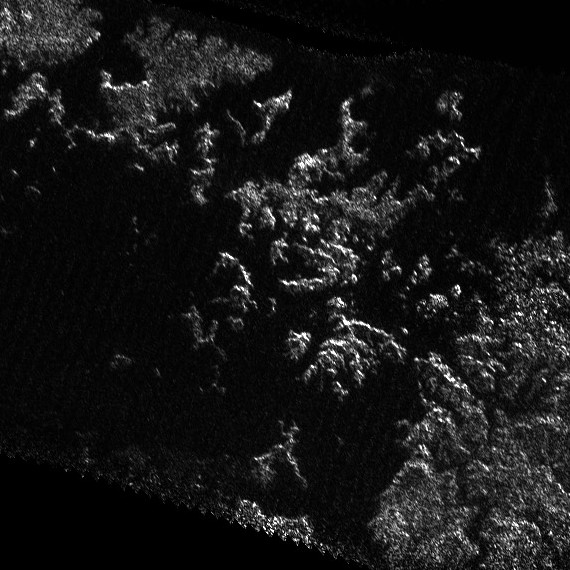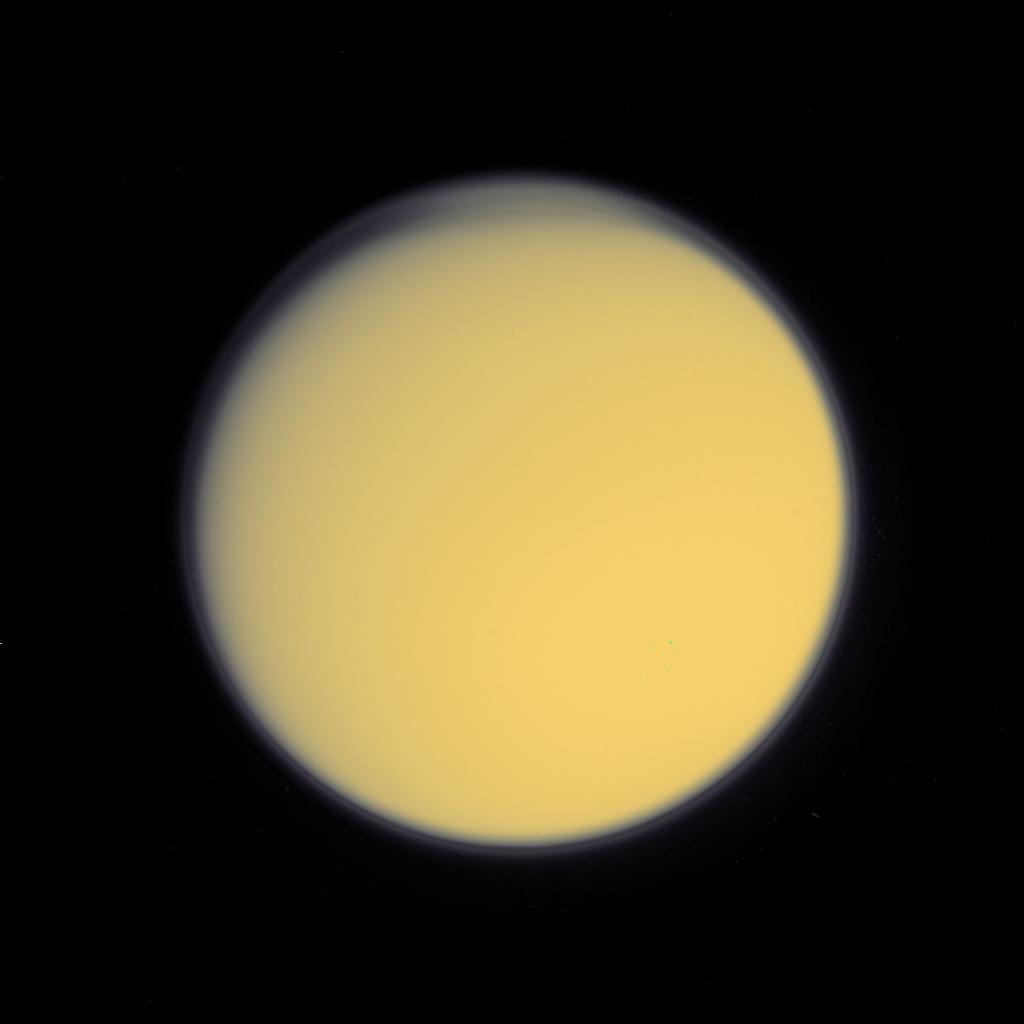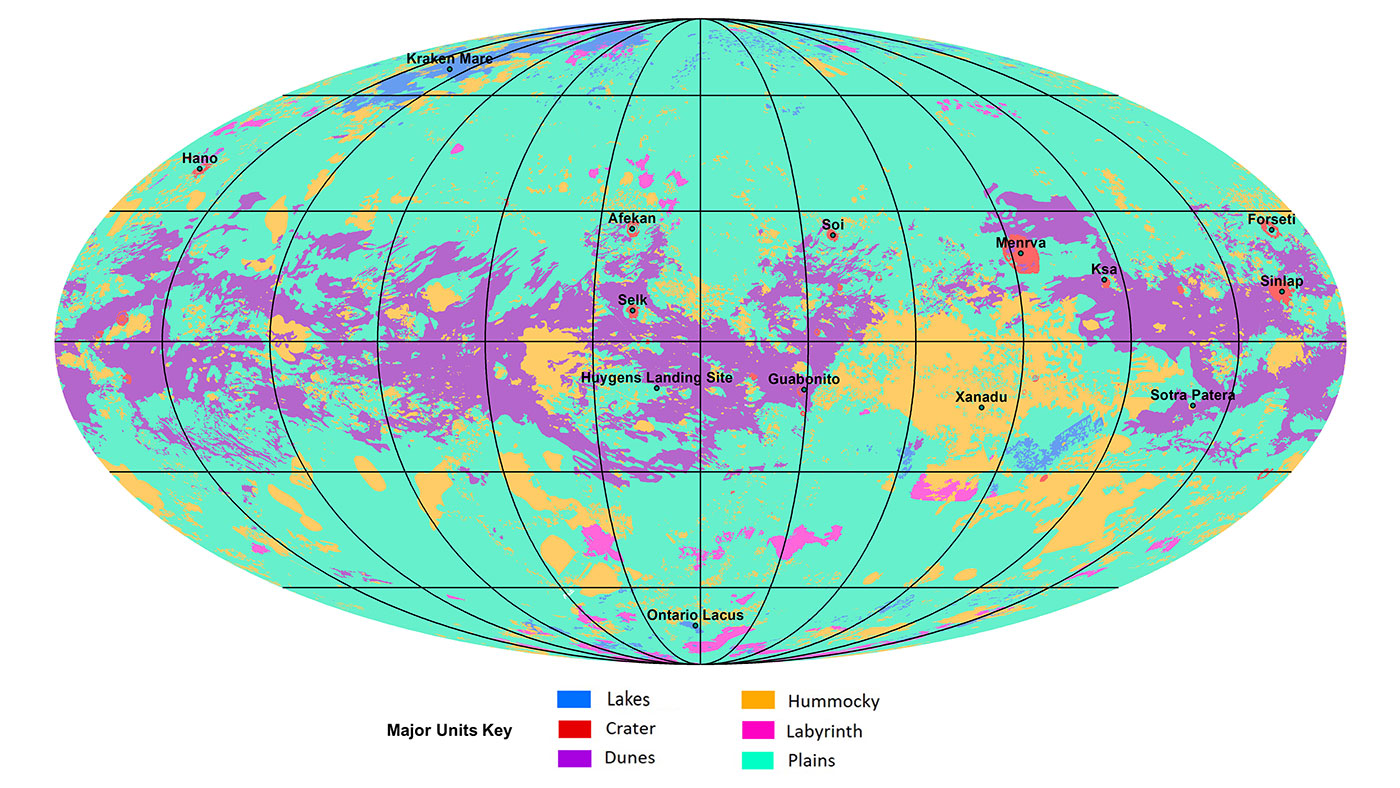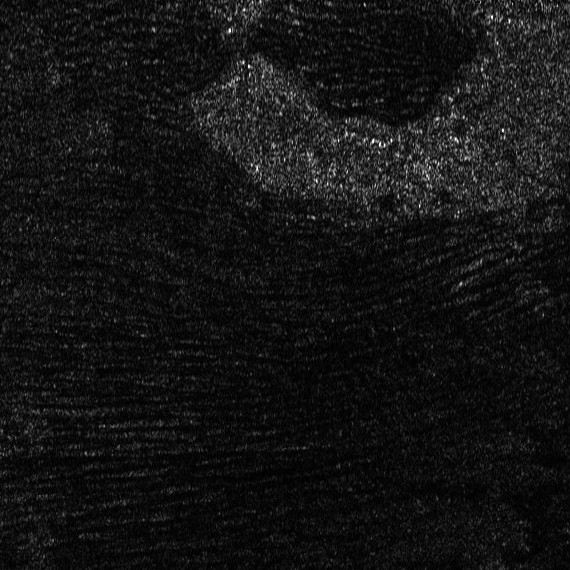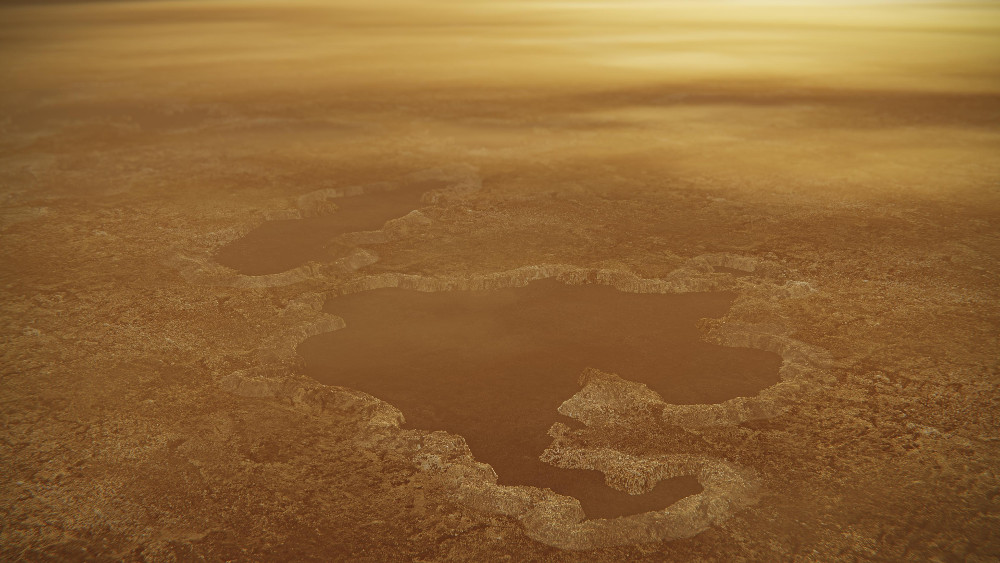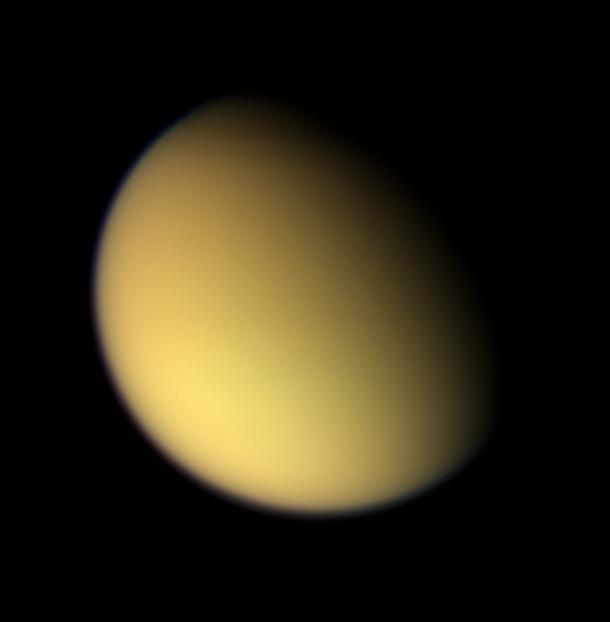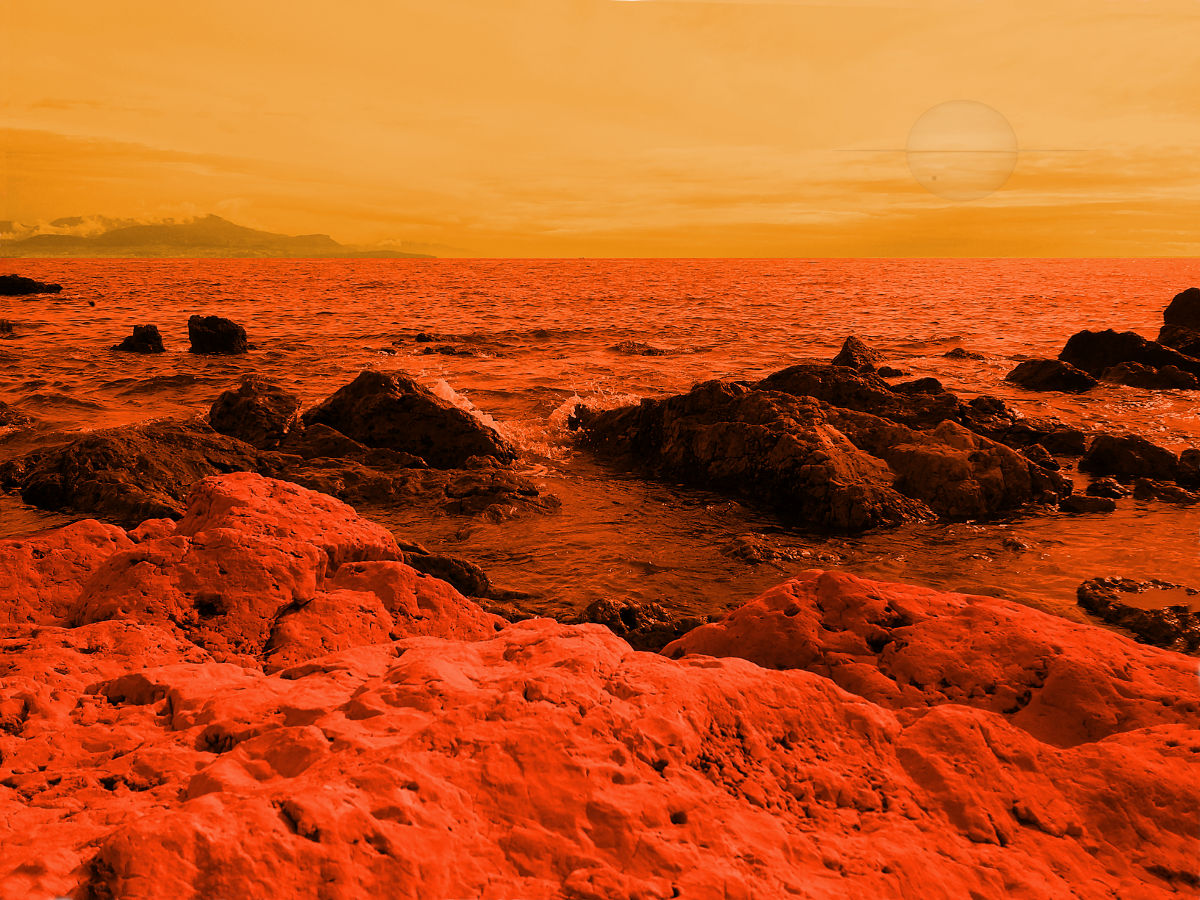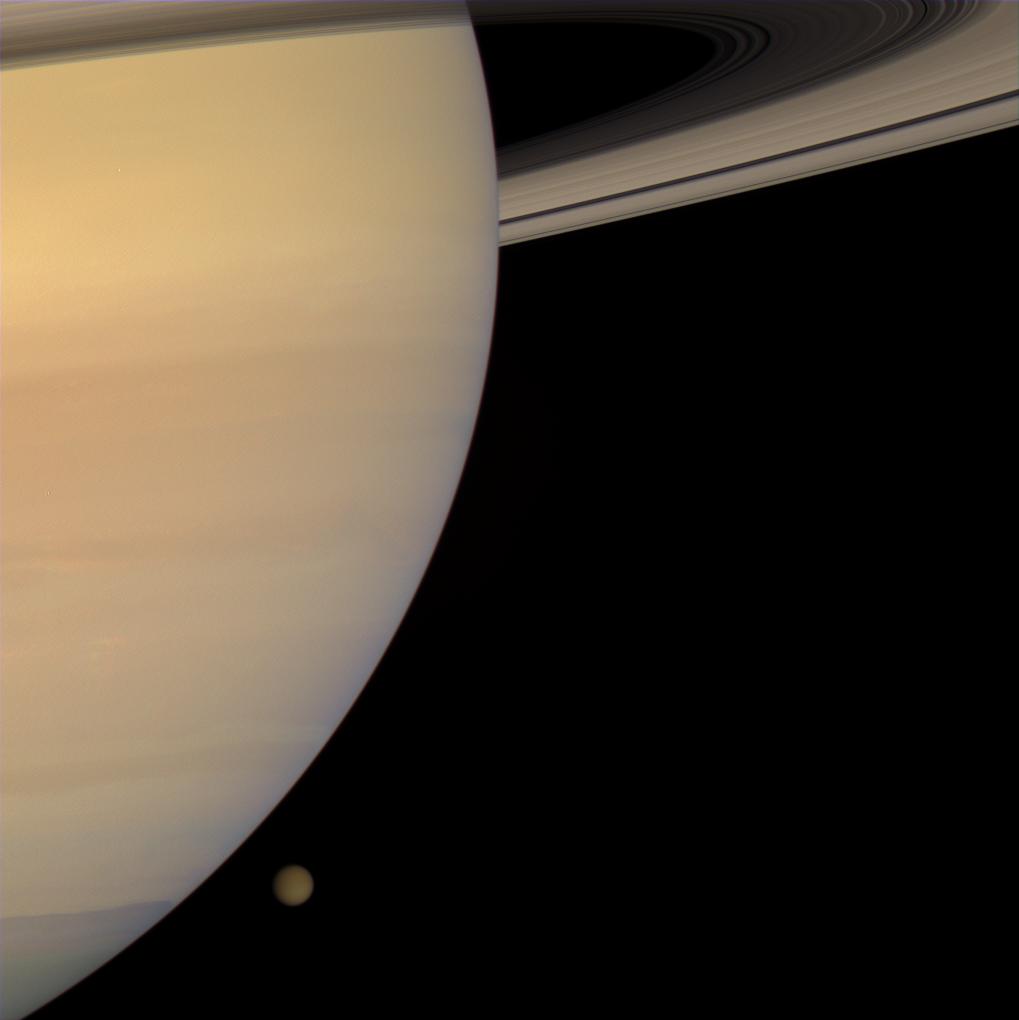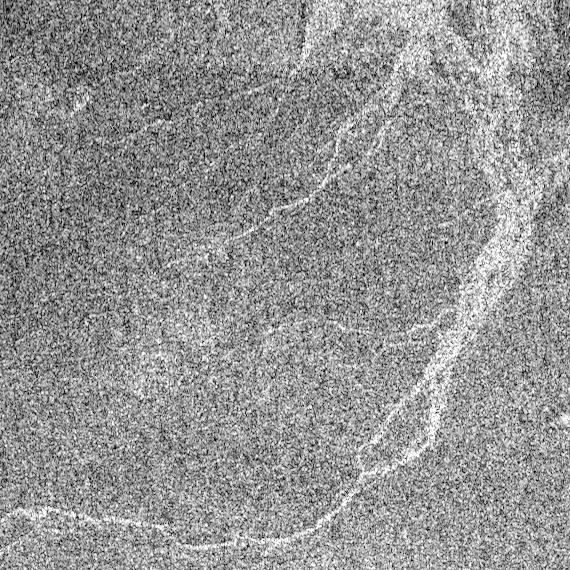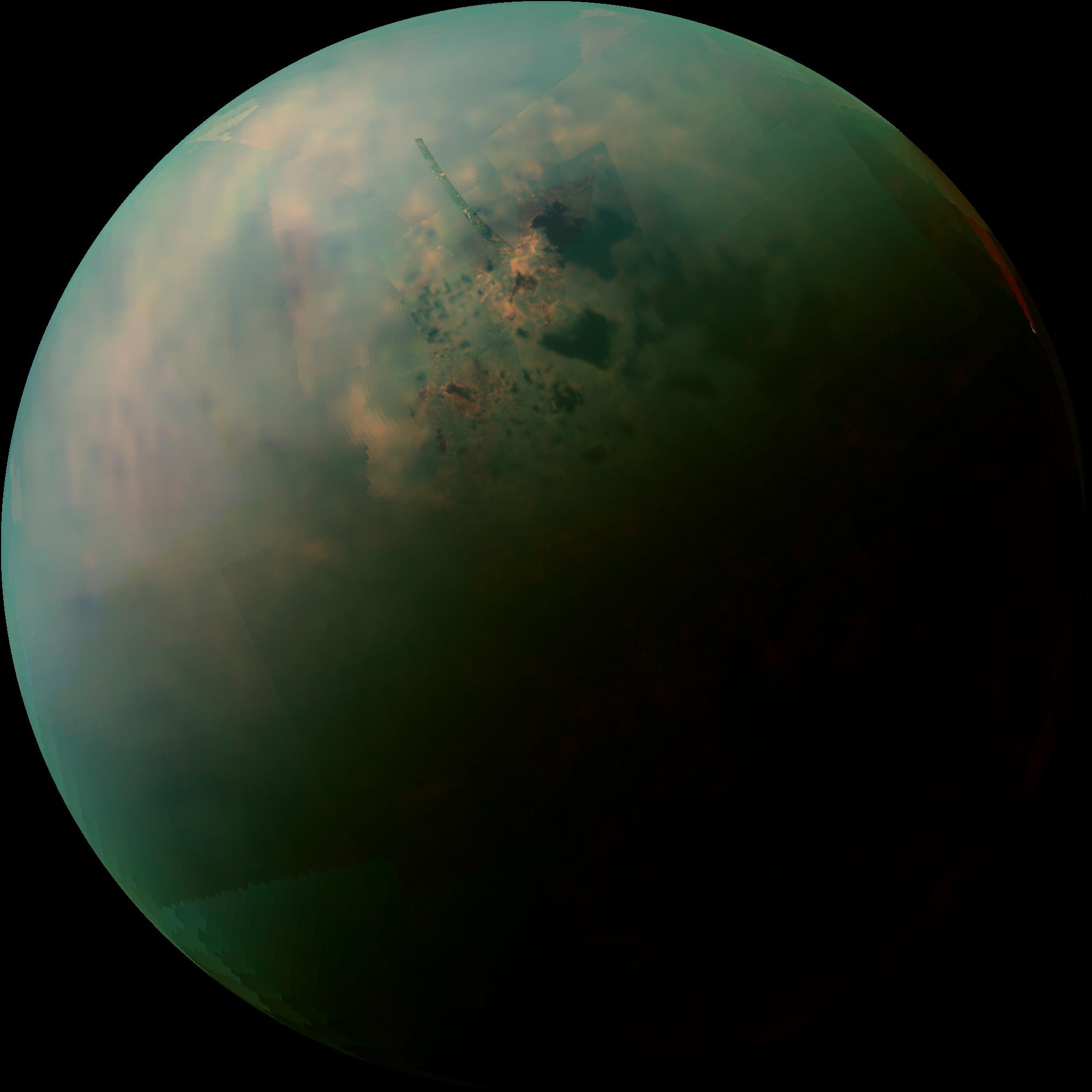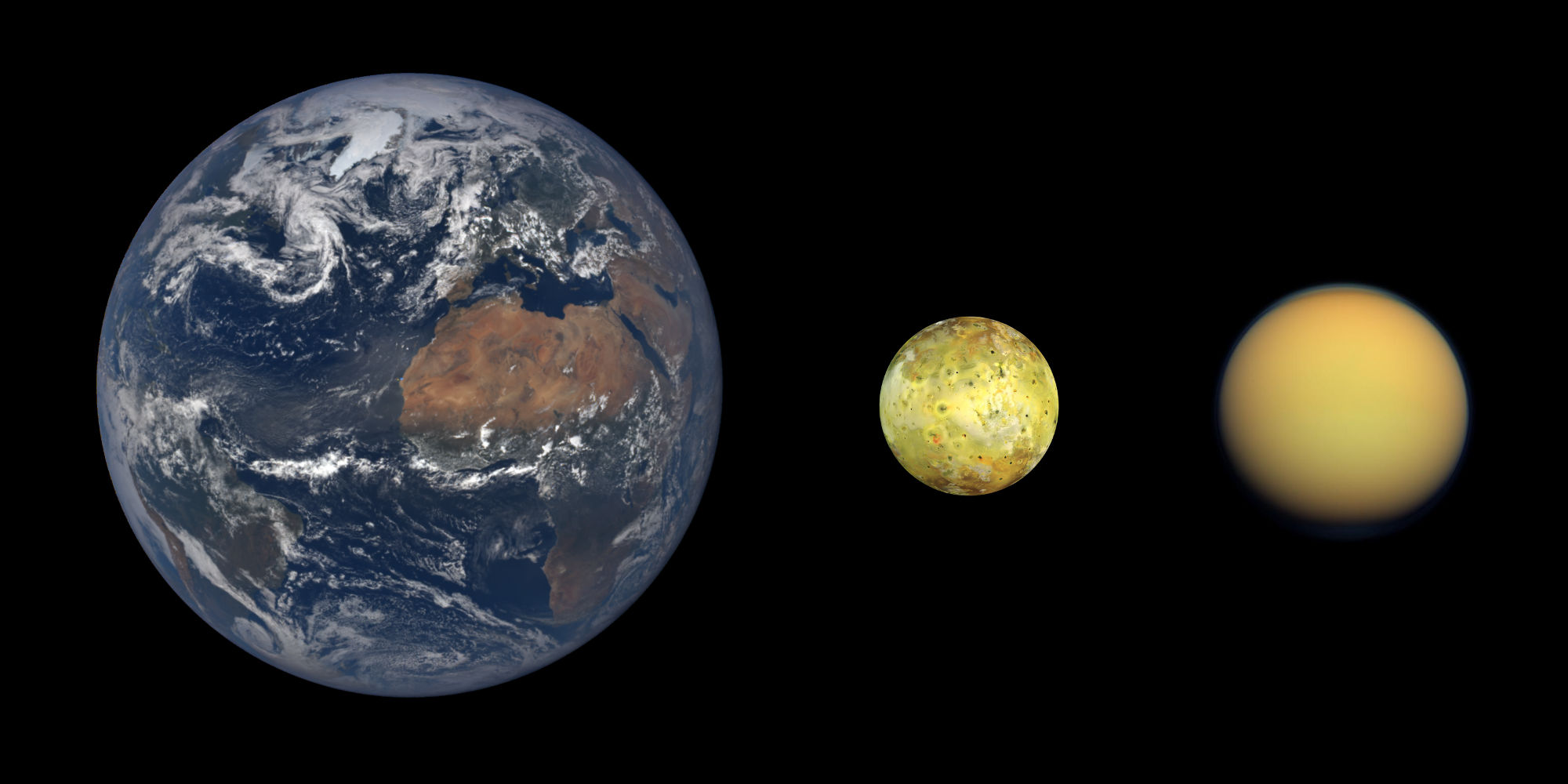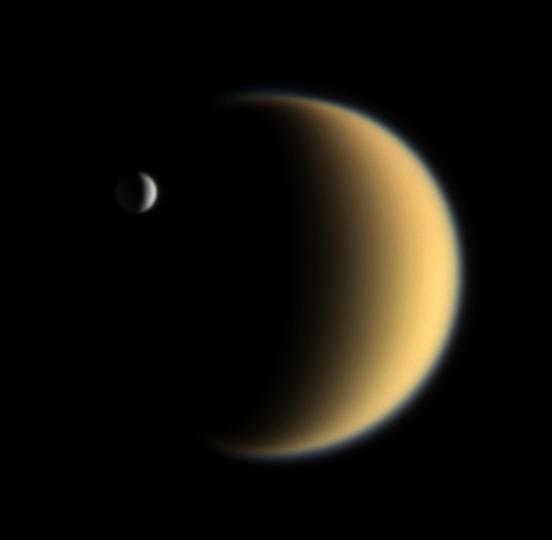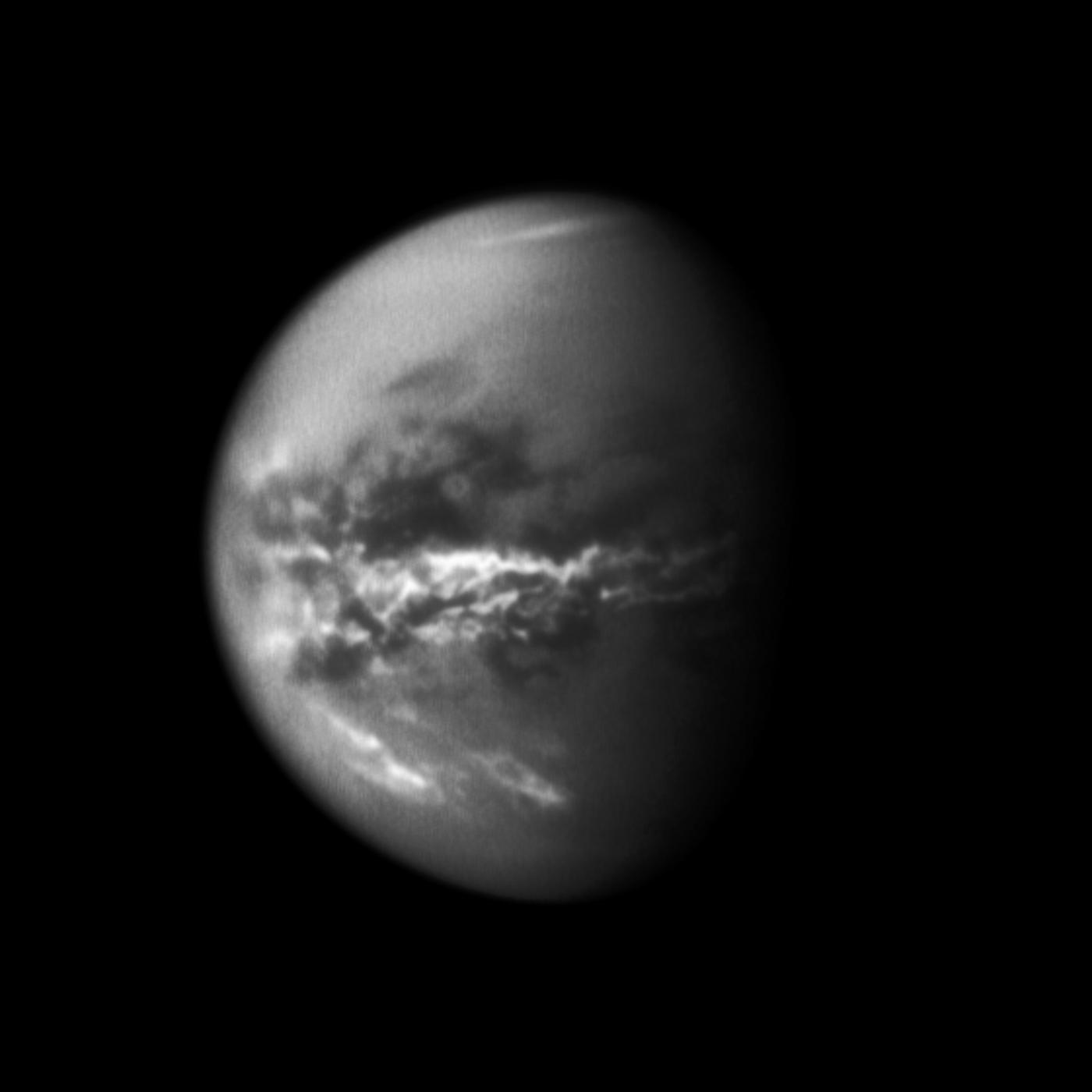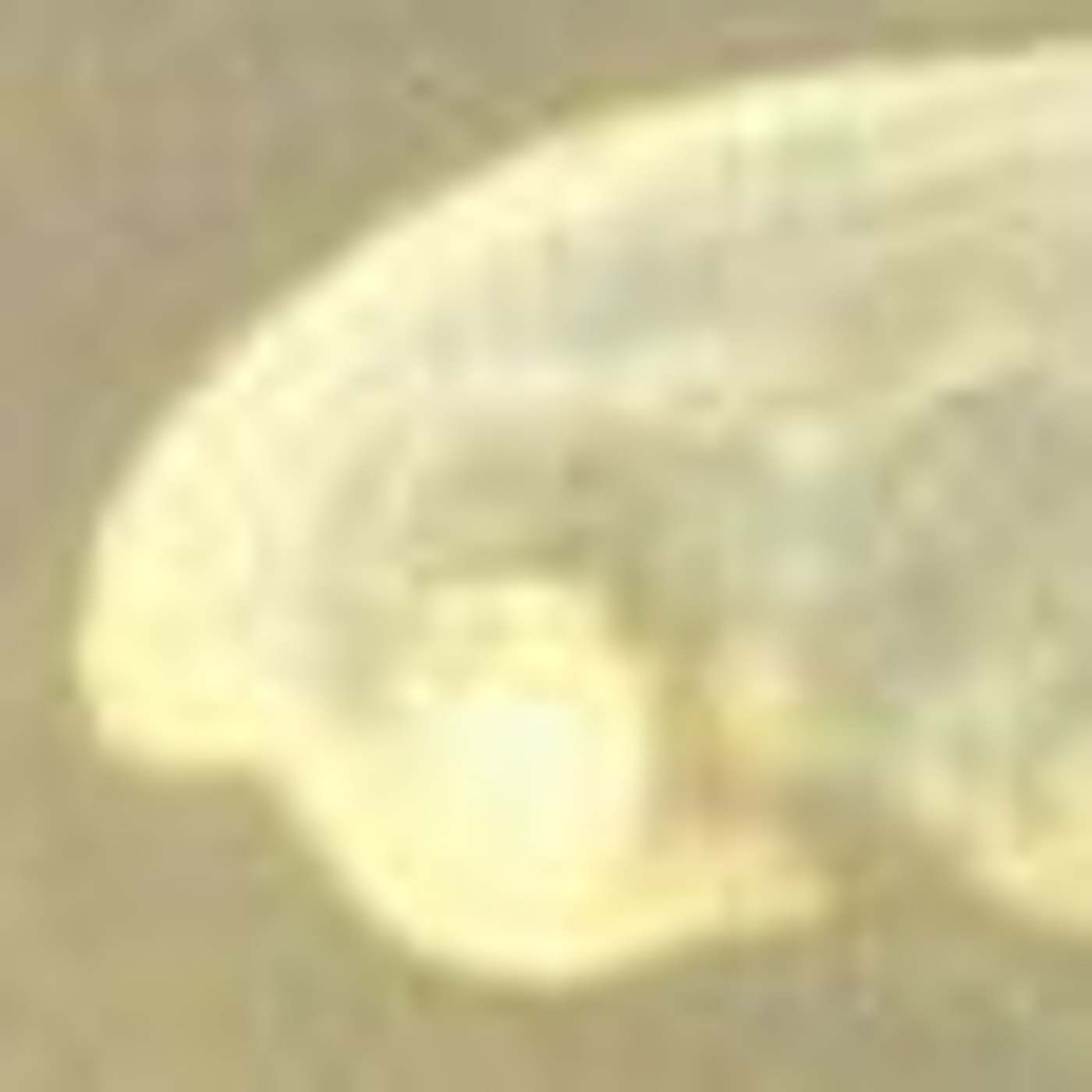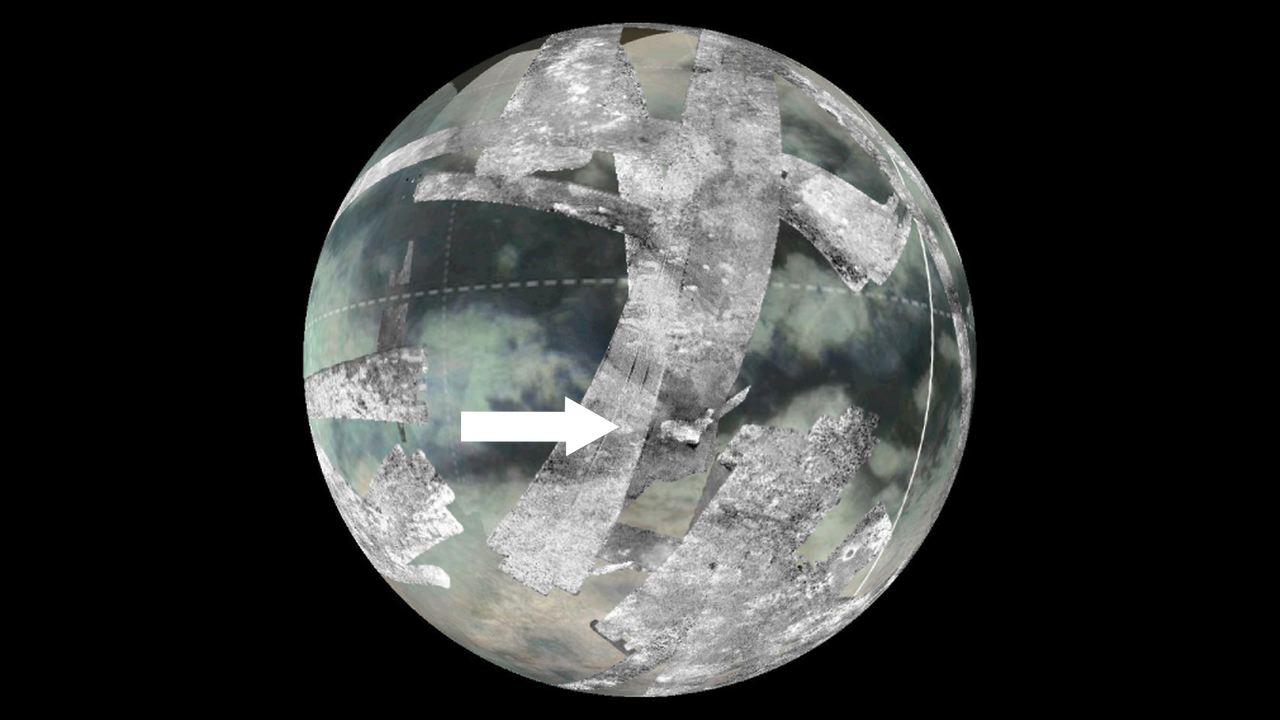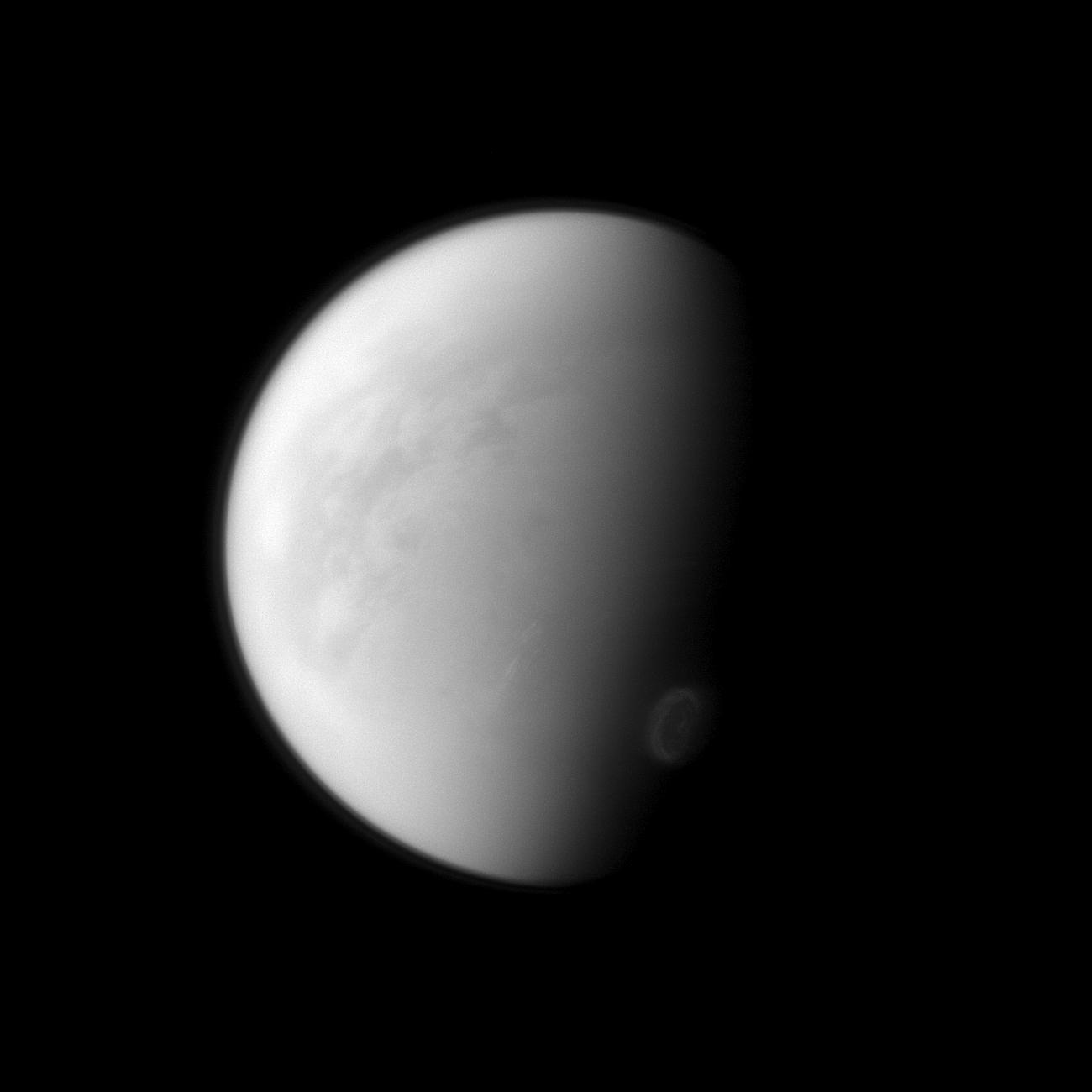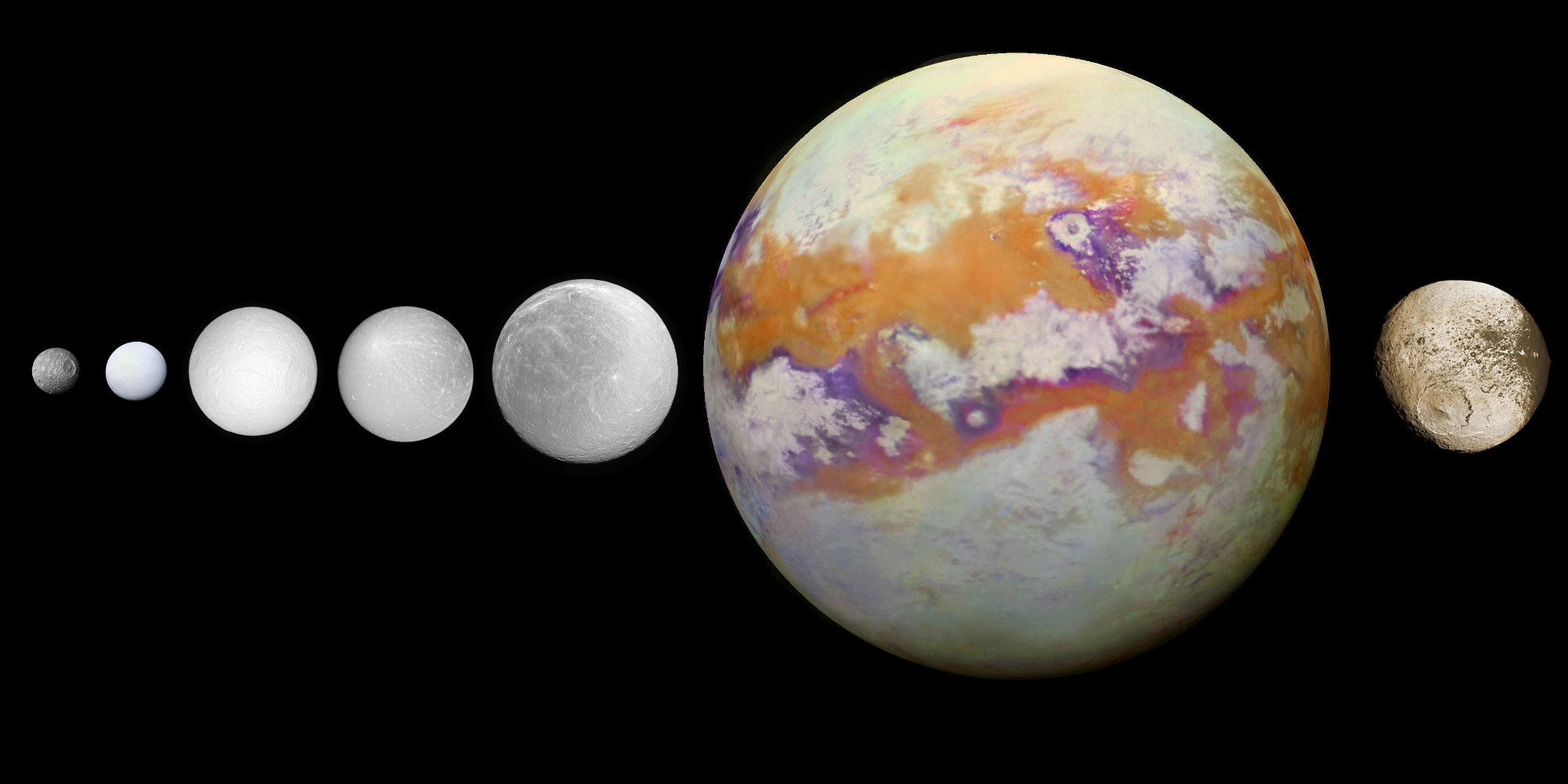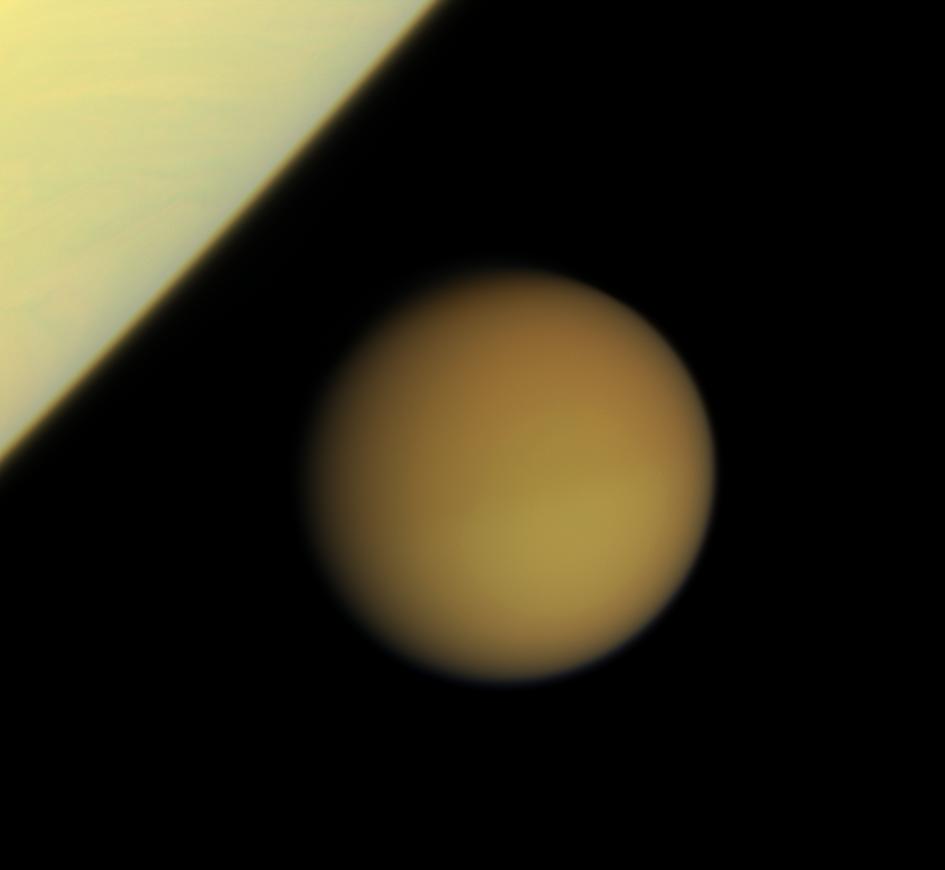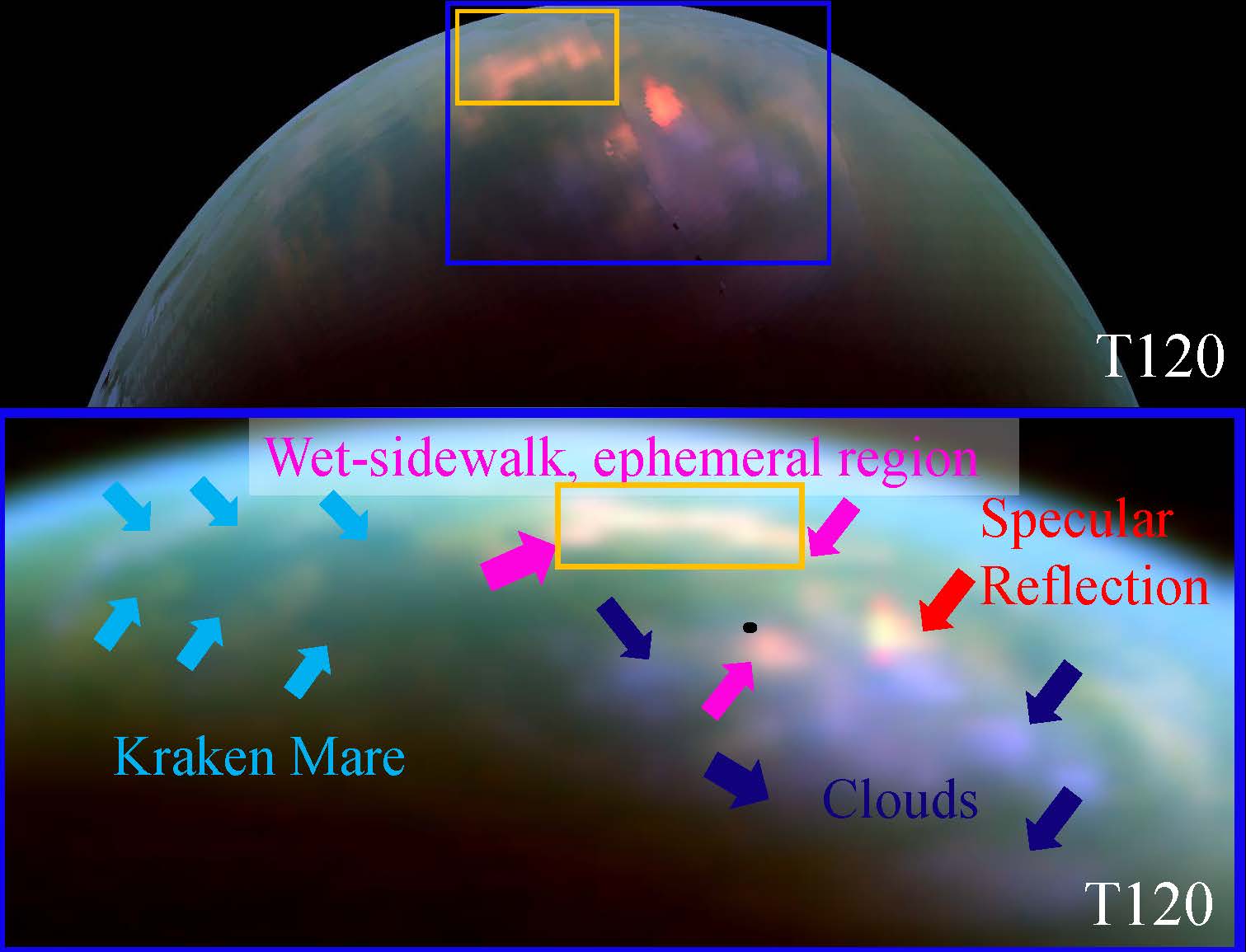Titan News 2019
December 9, 2019 : A New Laboratory Experiment Proposed By Kendra Farnsworth Reveals A Rapid Development Of Bubbles In A Mixture Of Methane And Ethane Strengthening The Hypothesis Of Bubbles In The Famous « Magic Islands » Of Titan
A new study entitled « Nitrogen Exsolution and Bubble Formation in Titan's Lakes », recently published in the journal Geophysical Research Letters and proposed by a team of researchers from the University of Arkansas, reveals the rapid development of bubbles in a mixture of methane, ethane and nitrogen in a laboratory experiment strengthening the hypothesis according to which bubbles may develop in the famous Magic Islands of Titan. Kendra Farnsworth who is the first author of the research work and who is a doctoral candidate in the Arkansas Center for Space and Planetary Sciences tried to reproduce the atmospheric conditions of Saturn's largest moon in one of the center's five planetary simulation chambers. The environment of the Opaque Moon appears to be rich in molecular nitrogen and in methane. During the Cassini-Huygens mission in the Saturn System, we have been in a position to clearly identify lakes, seas or rivers in the high latitudes of the giant moon. The composition of the pools of liquids can vary depending on the area, on the latitude or on the season. Methane, ethane or propane can appear in their liquid form on the surface of Titan.
Kendra Farnsworth who performs maintenance on the Titan Chamber for the Arkansas Center for Space and Planetary Sciences was in a position to determine that, in a harsh environment resembling the environment of Titan, a combination of methane, ethane and nitrogen generates rapid bubble formation. The formation and the development of bubbles had already been hypothesized to explain the phenomenon of the Magic Islands. The Magic Islands represent transient bright patches inside the major lakes or seas found in the high latitudes of the northern hemisphere in some radar views obtained from the Radar Mapper of the Cassini spacecraft during its long mission in the Saturn System. The Cassini orbiter had performed multiple flybys of Titan collecting a huge amount of data with its various instruments. Planetologists have had the opportunity to compare several radar views of the same pools, lakes or seas in order to understand their dynamics or their nature. Close to the coastline of Ligeia Mare, inside the pool which is relatively dark and quite uniform in radar views, large bright patches had taken shape. Then, those bright patches had evolved and dissipated or disappeared.
The image above represents a portion of the radar swath obtained from the Cassini spacecraft on May 12, 2007 during the T30 Flyby of Saturn's largest moon. The portion is 100 km wide and 100 km high. A portion of Kraken Mare, the largest pool of liquids on Titan, can be clearly seen. One can notice numerous islands in particular. The phenomenon of the Magic Island may not be related to the presence of a real island. The new research work strengthens the hypothesis of a field of bubbles producing the radar signature of an island. Credit for the original radar view: NASA/JPL/Cassini RADAR Team/Jason Perry. Credit for the montage: Marc Lafferre, 2019.
December 4, 2019 : A New Study Proposed By Ellen C. Creecy Reveals Relatively Strong Seasonal Variations In The Energy Budget Of Titan
A new research work entitled « Seasonal Variations of Titan's Brightness », recently published in the journal Geophysical Research Letters and proposed by a team involving Ellen C. Creecy, reveals that Titan unveils relatively strong seasonal variations in its energy budget. The huge amount of data acquired from the Cassini spacecraft during its long mission in the Saturn System from 2004 to 2017 has allowed us to perform multiple studies regarding the dynamics of the Titanian atmosphere or regarding the climate and the meteorology of Saturn's largest moon. Due to the remarkable dynamics of its atmosphere, Titan appears to be a really complex world where the geology or the landscape can be reminiscent of our own geology or landscape. The study of the energy budget of Titan can have major implications for the study of our own climate or meteorology, here on Earth. The planetologists who analyze the weather and the climate of the Opaque Moon evaluate the amount of solar energy absorbed by the giant moon as well as the thermal energy it emits.
The study of Saturn's largest moon can bring key information regarding our own world simply because there a remarkable similarities between the meteorological cycle of Titan and the meteorological cycle of the Earth. Titan unveils lakes, seas and rivers like the Earth and clouds can take shape and produce rainfall events or even snowfall events on Titan like on Earth. Titan is to a certain extent a mini-Earth where evaporation processes, condensation processes and rainfall processes can be encountered. However, the hydrological cycle of Titan is based on methane rather than water. In the harsh environment of Titan, water can only appear in its solid form on the surface and hydrocarbons like methane, ethane and propane can appear in their liquid form. Ellen C. Creecy who is a doctoral student in the Department of Earth and Atmospheric Sciences at the University of Houston and who is the first author of the study upon seasonal variations in the energy budget of the Orange Moon pointed out : « By studying Titan, we can learn a lot about Earth. » We can better understand our atmosphere or our climate by studying other atmospheres in the Solar System. Titan and Venus are among those worlds which can bring key information upon the level of understanding of our atmosphere.
The image above reveals the disk of Titan at the beginning of the Cassini-Huygens mission in the Saturn System. The image appearing with artificial colors was produced on the basis of data obtained on October 24, 2004 from the Narrow-Angle Camera of the Cassini orbiter with a filter sensitive to near-ultraviolet light. One can notice in particular the detached haze layer found in the upper atmosphere of the Hazy Moon. At the time of the observation, the southern hemisphere was experiencing the Summer period whereas the northern hemisphere was experiencing the Winter season. Image credit: NASA/JPL/Space Science Institute.
November 19, 2019 : Planetologists Have Finalized And Unveiled The First Global Geologic Map Of The Giant Moon Titan
A new global geologic map of Saturn's largest moon Titan has been unveiled on the basis of the large amount of data obtained from the Cassini spacecraft during its long mission in the Saturn System from 2004 to 2017. One can notice, in this map, the remarkable diversity of the landscape. Titan is clearly an active world where the surface and the dense, deep, opaque or hazy atmosphere are interacting to engender captivating landscape features. Most moons of the Solar System are devoid of any atmosphere. As a result, their surface is dominated by impact craters, from tiny impact craters to giant impact craters. Titan is in a completely different category of worlds due to the action of its thick atmosphere which engenders significant erosional processes. The new global map only reveals a few apparent craters. Those observations demonstrate that Titan's surface is relatively active or young. The meteorology of our planet is dominated by liquid water. Water is frozen or appears as ice on Titan's surface due to the extremely low environmental temperatures. Therefore, the meteorology of the Opaque Moon is not based on liquid water or water vapor.
However, a parallel can be drawn between the meteorological cycle of the Earth and the meteorological cycle of Titan since methane on Titan plays a relatively similar role to that of water on Earth. There are evaporation processes, condensation processes and precipitation processes on Titan like on Earth but the molecule involved on Titan is methane instead of water. Methane or ethane which represent gases in the environment of the Earth can appear in their liquid form on the surface of Saturn's largest moon because the environmental temperature is particularly low, around minus 179 degrees Celsius, minus 290 degrees Fahrenheit or 94 Kelvin. Rosaly Lopes who is a planetary geologist at NASA's Jet Propulsion Laboratory in Pasadena, California and who is lead author of a new study mobilized to generate the global geologic map of Titan pointed out : « Titan has an active methane-based hydrologic cycle that has shaped a complex geologic landscape, making its surface one of most geologically diverse in the solar system. » The Earth and Titan are the only known worlds in the Solar System where pools of stable liquid can be found on the surface.
The image above corresponds to the first global geologic map of the Opaque Moon. The map which was recently unveiled was produced on the basis of infrared or near-infrared data and radar data acquired from the Cassini orbiter during its long mission in the system of the Ringed Planet Saturn. One can notice in particular the land of lakes and seas in the high latitudes of the northern hemisphere where Kraken Mare, the largest body of surface liquids on Titan, can be found. Image credit: NASA/JPL-Caltech/ASU.
October 17, 2019 : A New Study Based On Laboratory Experiments Suggests That Cosmic Radiations May Engender Aromatics Feeding The Dunes Of Titan
A new study entitled « Low-temperature synthesis of polycyclic aromatic hydrocarbons in Titan's surface ices and on airless bodies », published in Science Advances on October 16, 2019 and proposed by a team composed of Matthew J. Abplanalp, Robert Frigge and Ralf I. Kaiser reveals that the interaction between galactic cosmic rays and acetylene ices in the harsh environment of Titan may engender aromatics fuelling the well-known dunes of Saturn's largest moon. The scientists performed laboratory simulation experiments involving radiations mimicking galactic cosmic rays and acetylene ices that can be found near the dunes of the Opaque Moon. They came to the conclusion that the interactions between galactic cosmic radiations and acetylene ices in a relatively low-temperature environment can lead to the development of Polycyclic Aromatic Hydrocarbons such as benzene, naphthalene and phenanthrene. The team of researchers believes that those hydrocarbons may be encountered in the dunes found at low or mid-latitudes on Titan or that they may represent building blocks of the exotic dunes of the giant moon.
Thanks to the Radar Mapper of the Cassini spacecraft, we know today that the relatively dark areas found in the low or mid-latitudes of Titan are dominated by Seif dunes or linear and parallel dunes extending over long distances. There are many hypotheses regarding the nature and the origin of those dunes. The prevailing theory advances that the dunes have developed on the basis of organics or hydrocarbons found in the global haze. If the molecules, compounds or particles of the haze become heavy enough, they can fall to the surface and they are likely to produce dunes over time. The hydrocarbons or organics found in the upper part of the opaque atmosphere can be engendered via complex interactions between UV light from the Sun and the elements, ions or molecules of the environment. The new research work has demonstrated another potential mechanism to generate the dunes that we can observe on Titan today. There can be a type of snowfall involving relatively complex organics or hydrocarbons engendered via the interaction between radiations from the Sun and particles or molecules from Titan's atmosphere but there can also be chemical reactions on the surface under the influence of galactic cosmic rays.
The image above represents a portion of a radar swath of Titan's surface obtained from the Cassini spacecraft on May 28, 2008 during the T44 Flyby. The landscape portion is 100 km wide and 100 km high. One can clearly notice the relatively sharp contrast between bright areas and dark areas. The dark areas are dominated by relatively parallel and linear dunes extending over long distances. The dunes of Saturn's largest moon may be rich in organics and hydrocarbons like benzene. Credit for the original radar view: NASA/JPL/Cassini RADAR Team/Jason Perry. Credit for the montage: Marc Lafferre, 2019.
September 10, 2019 : Some Methane Lakes Of Titan Appearing In Craters Generated By Explosions Of Nitrogen ?
A new study entitled « Possible explosion crater origin of small lake basins with raised rims on Titan », published in Nature Geoscience on September 9, 2019 and proposed by a team involving Giuseppe Mitri, suggests that some methane lakes of Saturn's largest moon Titan may appear in craters generated by explosions of nitrogen. Thanks to radar data acquired from the Cassini orbiter, we know, now, that most lakes, seas and rivers on Titan are found in its high latitudes or in its polar regions. The north polar region appears to be the most humid area with large pools of liquid and with a multitude of small lakes. The pools of liquid tend to be dominated by methane in the north polar region. Researchers try to determine how those lakes or seas formed. Some planetologists have advanced that dissolution processes and erosional processes must play a key role in the development and in the dynamics of the lakes or seas. However, a new scenario involving explosions of nitrogen may explain the surprising morphology of some small methane lakes of the Opaque Moon.
The radar data obtained with the Radar Mapper of the Cassini spacecraft during its mission in the Saturn System have clearly shown that some small lakes found in the high latitudes of the northern hemisphere unveil steep rims that can be hundreds of feet high. That strange topography around the lakes may be closely related to explosions of warming nitrogen which would have engendered the basins in which the methane lakes have taken shape according to the new research work performed by Giuseppe Mitri and his collaborators. A methane cycle comparable to the water cycle of our planet can be observed on Titan. One can encounter evaporation processes, condensation processes, clouds and rainfall events on that enigmatic moon of the Ringed Planet. The size or the level of the lakes or seas can change over time due to seasonal factors. However, there may be internal sources of methane or ethane which could fuel the lakes or seas. Planetologists try to gather new clues regarding the nature and the origin of the pools of methane or ethane on Titan because the environment seems quite complex.
The image above represents an artistic view of one of the small lakes of Titan where steep and elevated rims have been observed in radar data obtained from the Cassini orbiter. That's the case for Winnipeg Lacus in the high latitudes of the northern hemisphere for instance. Has Winnipeg Lacus taken shape in a crater produced by an explosion involving warming nitrogen ? Image credit: NASA/JPL-Caltech.
September 5, 2019 : A New Study Proposed By Krista Soderlund Reveals The Potential Influence Of The Rotation Speed Of The World On The Potential Dynamics Of The Presumed Subsurface Ocean Of Europa, Ganymede, Enceladus And Titan
A new research work entitled « Ocean Dynamics of Outer Solar System Satellites », published on July 29, 2019 in the journal Geophysical Research Letters and proposed by Krista Soderlund reveals the potential influence of the rotation speed of the world on the dynamics of the presumed subsurface ocean of four moons of the Solar System. In the study, Krista Soderlund who is a specialist on planetary fluid dynamics at the University of Texas in Austin focused her attention on Europa and Ganymede which are two moons of the Gas Giant Jupiter and on Enceladus and Titan which are two moons of the Ringed Planet Saturn. Our world is dominated by oceans whose dynamics has been intensively studied by meteorologists or planetologists on the basis of satellite data in particular. No other world in the Solar System contains any ocean of liquid water on its surface. However, Titan, the largest moon of Saturn, contains lakes, seas or rivers of liquid hydrocarbons in its high latitudes or in its polar regions.
Most moons in the Solar System are devoid of any atmosphere and are heavily cratered. Yet, we have become aware that many worlds of the Solar System may contain a subsurface layer dominated by liquid water. In other words, they may contain an internal ocean. The Dwarf Planet Pluto, the largest moon of Neptune Triton, Enceladus and Titan, Europa and Ganymede and even the Dwarf Planet Ceres may contain a subsurface ocean dominated by liquid water beneath their external crust. We've clearly observed that worlds of the Outer Solar System like Enceladus or Triton can be remarkably dynamic in terms of geology or internal activity. We now know that there are geysers on Triton or Enceladus. The fractured surface of Europa implies the potential presence of a liquid layer beneath the icy shell. We try to gather clues regarding the hypothetical subsurface ocean of worlds like Europa or Enceladus. The new study shows the potential relationship between the rotation rate of the world and the ocean currents of the presumed subsurface ocean on the basis of the rotating convection theory and numerical simulations.
The image above shows a mosaic of views of Titan and Enceladus represented at scale. The original view of Titan was generated on the basis of data acquired with the Wide-Angle Camera of the Cassini orbiter on January 30, 2012. Images obtained using red, green and blue spectral filters were mobilized to generate the original view of Saturn's largest moon in natural colors. Only a portion of the original view of Titan is visible in the mosaic. The original view of the tiny moon Enceladus which appears particularly bright was captured in visible light with the Narrow-Angle Camera of the Cassini spacecraft on October 14, 2009. Both moons may contain a subsurface ocean dominated by liquid water. Credit for the original view of Titan: NASA/JPL-Caltech/ Space Science Institute. Credit for the original view of Enceladus: NASA/JPL/Space Science Institute. Credit for the montage: Marc Lafferre, 2019.
August 19, 2019 : Titan Is A Giant Puzzle Which Might Tell Us A Lot Regarding The Secrets Of Nature
The largest moon of Saturn has all the ingredients to draw our whole attention. Almost all the moons of the Solar System are devoid of any atmosphere. That's not the case for Titan which is covered with a remarkable atmosphere. Titan's atmosphere is completely opaque from outer space in the visible spectrum and is much thicker than our own atmosphere. That's surprising because the Earth is much more massive than Titan. For instance, Ganymede, the largest moon of Jupiter and the largest moon in the Solar System, is devoid of any atmosphere. How can we explain that apparent paradox ? Is the atmosphere of Titan stable over the geological time scale ? Are there internal sources to the gas layer covering the globe ? The atmosphere of the Orange Moon is reminiscent of the atmosphere of Venus which is also completely opaque and which is extremely thick and dense. However, the composition of Titan's atmosphere is radically different from the composition of the Venusian atmosphere. In fact, to a certain extent, the Titanian atmosphere looks like our atmosphere in terms of composition.
Titan's atmosphere is mostly composed of molecular nitrogen like our atmosphere but the second most abundant gas in Titan's atmosphere is not oxygen like in the atmosphere of the Blue Planet. The second most abundant gas in Titan's atmosphere is methane. Water can't appear in its liquid form on Titan's surface because the environmental temperature is extremely low at the level of the ground. The mean environmental temperature on Titan's surface is around minus 179 degrees Celsius, minus 290 degrees Fahrenheit or 94 Kelvin. There are the right combinations of atmospheric pressure and environmental temperature at the level of Titan's surface for the presence of pools of methane, ethane or even propane. Water can only appear in its solid form on the surface of the Orange Moon. A parallel can be drawn between the meteorological cycle of the Earth based on water and the meteorological cycle of Titan based on methane. Clouds of methane or ethane have been clearly observed in the Titanian atmosphere during the Cassini-Huygens mission.
The image above reveals the Titanian disk in natural colors. The image was generated on the basis of data obtained with the Wide-Angle Camera of the Cassini spacecraft on August 21, 2005. The views were taken using red, green and blue spectral filters at a distance of about 213,000 kilometers or 132,000 miles from the Opaque Moon and at a Sun-Titan-probe, or phase, angle of 55 degrees. The image clearly shows, in the visible spectrum, that the surface can't be discerned from outer space due to the exotic haze. However, in the infrared or near-infrared spectrum, the surface of the giant moon can be discerned from outer space. Image credit: NASA/JPL/Space Science Institute.
August 18, 2019 : Will We Ever Walk On The Surface Of Titan ?
On July 21, 1969, Neil Armstrong became the first individual to walk on the Moon. Between 1969 and 1972, twelve astronauts have evolved on the Moon. On July 21, 2019, we celebrated the 50th anniversary of the historical event involving Neil Armstrong, Buzz Aldrin and Michael Collins. Recently, a Chinese probe known as Chang'e 4 landed, for the first time in history, on the surface of the far side or the « Dark Side » of the Moon. That feat appears clearly inspiring for researchers, planetologists or the general public who want to learn more about the geology of the Moon. A growing interest in the exploration of the Moon has been observed in previous weeks or months. Today, several countries, governments or companies are developing projects to explore or even colonize the Moon. For instance, a space station around the Moon or a laboratory on the surface of our natural satellite may take shape in the near future.
The Moon is the only world beyond the Earth where we have walked on the surface. The environment of Venus is too hostile with extremely high environmental temperatures and a particularly high pressure on the surface. The environmental temperature of Mercury which is devoid of any significant atmosphere is also extremely warm on the Sun-facing side and the highly cratered world is farther from the Earth than Venus. Currently, the « Red Planet » Mars is the only planet where we intend to send astronauts to walk on the surface. NASA has developed plans to send astronauts to the surface of the Red Planet in the coming years or decades. Several worlds beyond Mars draw our attention. That's the case for the Dwarf Planet Ceres, for Europa or Io which are moons of the Gas Giant Jupiter, for Enceladus or Titan which are moons of the Ringed Planet Saturn, for Triton which is the largest moon of Neptune or for Pluto which is the largest Dwarf Planet. Can we send spaceships with astronauts beyond the Moon or Mars ?
The image above represents a simulated view of a pool of hydrocarbons on Saturn's largest moon Titan. The disk and the rings of the Gas Giant Saturn can be discerned in the opaque atmosphere of Titan. In reality, Saturn may not be visible in the sky in the visible spectrum due to the thick haze of organics or hydrocarbons present in Titan's atmosphere. The apparent diameter of Saturn from the surface of Titan represents about 11 times the apparent diameter of the Moon from the surface of the Earth. The surface of Titan may be rich in tholins and the seas, the lakes or the rivers found in the high latitudes of the northern hemisphere of the giant moon may be dominated by methane. Image credit: Marc Lafferre, 2019.
August 6, 2019 : Specialists Of Exoplanets Or Exobiologists Recently Advanced That We Should Envisage Biosignatures Related To Other Solvents Than Water Like Liquid Methane That Can Be Found On The Surface Of Titan
Some planetologists argue that we should envisage the possibility of biosignatures related to other solvents than water in our search for signs of life beyond our planet. The only lifeform we know today is the lifeform found on our own world. That lifeform is intimately linked to liquid water. Our body is mainly composed of liquid water which represents about 65 percent of our weight. The concentration of water is even higher for organisms like plants or jellyfish. Liquid water is widespread on the surface of the Earth since oceans cover about 70 percent of the surface of our planet. On the basis of those observations, one can easily deduce that life can only form in an environment that is rich in liquid water. Most biologists believe that water is the only solvent that can lead to the formation and the development of life. The Earth is the only planet of the Solar System where liquid water can be found on the surface. Therefore, we don't know whether liquid water automatically leads to the formation or the development of life over time.
We know, now, another world of the Solar System where stable pools of liquid can be found. That world is Titan, the largest moon of Saturn. Most moons in the Solar System are devoid of any atmosphere but Titan is an exception. Titan contains a remarkable atmosphere which looks like the atmosphere of the Early Earth. The atmosphere of Titan is dominated by molecular nitrogen like the atmosphere of our planet today. However, the harsh environment of Titan's atmosphere is devoid of any significant amount of oxygen and contains a relatively significant fraction of methane. A meteorological cycle of methane comparable to the meteorological cycle of water on the Earth can be observed on Titan. In an environment relatively rich in carbon like our own environment, can life emerge or develop if there are stable pools of liquid methane or liquid ethane ? That's clearly a crucial question in the prospect of our understanding of the chemistry of organics or life in the universe. Some researchers discussed about that topic at the first annual TESS Science Conference at the Massachusetts Institute of Technology (MIT) on August 2, 2019.
The image above reveals a portion of Saturn and the disk of Titan in natural color. The view was produced on the basis of images acquired with the ISS Wide-Angle Camera of the Cassini orbiter, using red, green and blue spectral filters, on January 29, 2008. At the time of the observation, Titan was located at a distance of about 2.3 million kilometers or 1.4 million miles from the probe whereas Saturn was evolving at a distance of about 1 million kilometers or 630,000 miles from the spacecraft. Titan unveils lakes, seas and rivers of methane and ethane that may favor the development of life. Saturn may contain an ocean of metallic hydrogen. Can that hypothetical ocean engender life ? Image credit: NASA/JPL/Space Science Institute.
July 13, 2019 : A Team Of Researchers Led By Rosaly Lopes Tries To Understand The Chemistry And The Dynamics Of Organics Or Hydrocarbons In The Titanian Environment In Order To Evaluate Its Habitability
A group of scientists from NASA's Jet Propulsion Laboratory, led by Rosaly Lopes and funded by the NASA Astrobiology Institute, has undertaken major studies upon the chemistry and the dynamics of organics or hydrocarbons in the environment of Saturn's largest moon Titan. Multiple hydrocarbons or organics have already been clearly identified in the hazy atmosphere or on the surface of the giant moon of the Ringed Planet. The environmental temperature of Titan is particularly low with a mean temperature around minus 179 degrees Celsius, minus 290 degrees Fahrenheit or 94 Kelvin but complex chemical reactions involving hydrocarbons, organics or nitrogen can occur in that harsh environment. The atmosphere of the Opaque Moon may look like the atmosphere of the Early Earth which also represented a soup of complex hydrocarbons. Planetologists have been in a position to infer the presence of a subsurface ocean beneath the external crust of Titan thanks to gravity measurements performed during flybys carried out by the Cassini orbiter. Thus, some researchers believe that the presumed ocean of water may potentially host life.
The team of Rosaly Lopes tries to identify the potential chemical interactions between the presumed subsurface ocean, the presumed icy crust, the soil and the atmosphere. Is there a cycle of organics or hydrocarbons between the hypothetical ocean and the hazy atmosphere ? Scientists know that ultraviolet light from the Sun plays a key role in the chemistry of Titan's haze or in the chemistry of Titan's upper atmosphere. Hydrogen, methane and nitrogen can engender complex organics or hydrocarbons that can represent prebiotic molecules. Can any exotic lifeform use relatively simple organics or hydrocarbons produced in Titan's atmosphere ? The researchers have determined four major objectives. The first goal is to understand the potential mechanisms in the movement of organic molecules between the atmosphere, the surface and the presumed ocean. The second goal is to determine the types of process taking shape within the subsurface ocean which are likely to make it habitable. The third goal is to identify the potential biosignatures the hypothetical life can generate. The fourth goal is to understand the potential mechanisms in the upward movement of the potential biosignatures toward the surface where we could identify or detect them.
The image above represents a portion of a radar swath obtained from the Radar Mapper of the Cassini spacecraft during the T3 Flyby on February 15, 2005. One can clearly notice bright sinuous channels that may be related to cryovolcanism or an impact event. Are those channels dried-up rivers related to meteorological phenomena ? Each side of the view represents 100 km. Image credit: NASA/JPL/Cassini RADAR team/Jason Perry.
July 6, 2019 : Researchers From SMU In Dallas Will Try To Recreate The Environment Of Titan In The Laboratory In The Prospect Of The Dragonfly Mission
The Cassini-Huygens mission in the Saturn System came to an end in September 2017 with the targeted crash of the Cassini orbiter into the Gas Giant Saturn. A huge amount of scientific data regarding Saturn, its rings and its numerous moons has been collected by the scientists of the mission. Thus, they are in a position to better understand the chemistry, the climate, the meteorology or the internal activity of worlds like Saturn, Titan or Enceladus. Due to its remarkable dynamics and due to its complex chemistry involving hydrocarbons or organics, Titan draws our whole attention. That's why a new mission to Saturn's largest moon has been planned. In late June, NASA announced that we will fly back to Titan in less than two decades. The new mission known as Dragonfly will involve a drone or a rotorcraft that will explore a land of dunes and a major crater from the year 2034. We want to study the chemistry and the dynamics of the soil and the atmosphere. The probe or drone will do much more than the Huygens probe did since it will explore dozens of promising places. The long journey is expected to start in 2026.
Recently, the Southern Methodist University (SMU), located in Dallas, was awarded a grant of 195,000 dollars for a mission to simulate the environment of the Opaque Moon in the laboratory. One of the goals is to better understand the complex chemistry of Titan and in particular the chemistry of organics and hydrocarbons which may represent a pre-biotic chemistry or a chemistry that can lead to life. The project or the mission which is financed by the Houston-based Welch Foundation will be led by Tom Runcevski who is an assistant professor of chemistry in SMU's Dedman College of Humanities and Sciences and will involve Christina McConville who is a graduate student from SMU and who was awarded a fellowship, as well, by the Texas Space Grant Consortium. Christina McConville will bring her skills to make the mission advance. The work of the planetologists regarding the potential chemistry of Titan's environment is likely to help the scientists and the engineers of the Dragonfly mission prepare the future campaign of the drone or rotorcraft.
The image above reveals a portion of a radar swath obtained from the Radar Mapper of the Cassini orbiter during the T3 Flyby of February 15, 2005. Each side of the view represents 100 km. One can notice topographic features which appear to be dunes. Those dunes appear relatively linear and parallel. The rotorcraft of the Dragonfly mission may explore that type of terrain in the area of Shangri-La from the start of the mission on Titan in 2034. Credit for the original radar view: NASA/JPL/Cassini RADAR team/Jason Perry. Credit for the image adjustments: Marc Lafferre, 2019.
June 26, 2019 : A Team Of Researchers Led By Morgan Cable Reveals The Potential Presence Of Bathtub Rings Of Acetylene And Butane Around The Pools Of Titan
A new research work led by Morgan L. Cable and involving Tuan Hoang Vu and Robert P. Hodyss from the Jet Propulsion Laboratory of NASA in Pasadena (California) as well as Helen Elizabeth Maynard-Casely from the Australian Nuclear Science and Technology Organization, Kirrawee, NSW in Australia reveals, on the basis of observations and laboratory experiments, the potential presence of rings of acetylene and benzene around the lakes or seas of Saturn's largest moon Titan. The study entitled « The acetylene-butane co-crystal: A potentially abundant molecular mineral on Titan » was presented at the 2019 Astrobiology Science Conference at the Hyatt Regency Bellevue, Evergreen Ballroom in Washington on June 24, 2019. Titan is a really strange world rich in various types of hydrocarbons and organics and planetologists try to imagine or to anticipate the exotic chemistry involving organics that can take shape on the surface or in the atmosphere of the Opaque Moon. Thanks to laboratory experiments, the team of Morgan Cable was in a position to identify exotic minerals or exotic crystals that may exist on the giant moon of the Gas Giant Saturn.
The laboratory experiments were supposed to simulate the exotic environment of Titan where the air is dominated by molecular nitrogen and methane and where various types of organics or hydrocarbons can form. In fact, the composition of Titan's atmosphere is close to the composition of our atmosphere since both atmospheres are dominated by molecular nitrogen. However, oxygen which is relatively abundant in the atmosphere of the Earth is absent or completely absent in the Titanian atmosphere. The environmental temperature of the Orange Moon is extremely low with a surface temperature around minus 180 degrees Celsius, minus 292 degrees Fahrenheit or 93 Kelvin at « sea level ». Therefore, water can only appear in its solid form on the surface of the second largest moon in the Solar System. The gravity on Titan is lower than that of the Moon but, curiously, the atmospheric pressure on the surface of Titan is much higher than that of the Earth at sea level. On January 14, 2005, the Huygens probe had recorded an atmospheric pressure of 1,467 hPa on Titan's surface. A parallel can be drawn between the meteorological cycle of the Earth which is based on water and the meteorological cycle of Titan which is based on methane.
The image above represents a false-color mosaic of Titan which clearly reveals the land of lakes and seas in the high latitudes of Saturn's largest moon Titan. The view was generated on the basis of infrared data acquired from the Visual and Infrared Mapping Spectrometer (VIMS) of the Cassini orbiter during its mission in the Saturn System. The orange areas may contain compounds related to evaporation processes. A parallel can be drawn between those areas and salt flats on our planet but the nature of the compounds on the Titanian shorelines is likely completely different from that on the Terrestrial shorelines. Image credit: NASA/JPL-Caltech/University of Arizona/University of Idaho.
June 21, 2019 : Worlds Like Venus, The Earth, Mars, Io Or Titan Fuel The Analyses Of Planetologists Upon The Concept Of Habitable Zone
The discovery or the identification of a multitude of exoplanets which are planets evolving beyond the Solar System fuels our studies on the potential habitability of several worlds orbiting other stars than the Sun. Planetologists have developed the concept of Habitable Zone in order to identify the exoplanets which may host oceans, lakes, seas or rivers of liquid water. The Habitable Zone represents an area around the star where the environmental temperature is high enough or low enough to allow the potential presence of water in its liquid form on the surface of the planetary body, the planet, the moon or the Dwarf Planet. In the Solar System, Venus, the Earth and Mars are apparently in the Habitable Zone. However, a multitude of factors must be taken into account for the determination of the likelihood of oceans or seas of liquid water on any world. The atmosphere of Venus is remarkably dense and engenders a major greenhouse effect which prevents the development of oceans or seas of liquid water on its surface. The atmosphere of Mars is too thin to allow the presence of pockets, seas or oceans of liquid water on its surface. Moreover, the environmental temperature of Mars is generally too low to allow the presence of liquid water on its surface.
In the Solar System, we have identified many worlds which may contain subsurface oceans of liquid water. One can mention Europa and Ganymede around Jupiter, Enceladus and Titan around Saturn or the Dwarf Planet Pluto beyond Neptune. Tidal forces can play a major role in the development of a subsurface ocean, volcanoes, cryovolcanoes or geysers around Gas Giants. For instance, geysers developing in topographic fractures in the south polar region of Enceladus have been clearly identified during the Cassini-Huygens mission. Io, the famous moon of Jupiter, is by far the most active world in the Solar System in terms of volcanic activity. Tidal forces can have a major impact on the internal activity of many worlds even if those worlds evolve particularly far away from the Sun. The study of the multitude of worlds, planets or moons in the Solar System allows us to better evaluate the potential habitability of the numerous exoplanets we have identified in the Milky Way, in our own galaxy. The concept of Habitable Zone must be developed on the basis of many factors such as the environmental temperature, the atmospheric pressure or the composition of the atmosphere.
The image above reveals, from the left to the right, the Earth, Io and Titan at scale. Titan which is the largest moon of Saturn, Io which is a major moon of Jupiter and the Earth represent worlds containing liquid surfaces. Oceans of liquid water dominate the surface of our planet. Lakes, seas and rivers of methane and ethane can be found in the high latitudes of Titan. Io appears to be the most volcanically active world in the Solar System due to particularly strong tidal forces involving Jupiter and the other moons of the Gas Giant. Io also contains lakes but those lakes are made of lava. Those worlds reveal very different environments and illustrate the potential diversity of exoplanets. Credit for the original view of the Earth: DSCOVR. Credit for the original view of Io: NASA/JPL/University of Arizona. Credit for the original view of Titan: NASA/JPL-Caltech/Space Science Institute. Credit for the montage: Marc Lafferre, 2019.
May 23, 2019 : How Can We Explain The Apparent Contrast Between The Relatively High Level Of Internal Activity Of Enceladus, Titan Or Dione And The Relatively Low Level Of Internal Activity Of Moons Like Mimas Or Rhea ?
The System of Saturn is rich in mysteries. Some moons like Enceladus or Titan seem particularly active in terms of geology or internal activity whereas other moons like Mimas or Rhea seem to be inactive or much less active than those well-known worlds of the Gas Giant. Among the 62 moons orbiting the second largest Gas Giant in the Solar System, one can notice that most worlds orbiting Saturn are devoid of any atmosphere and unveil a highly cratered surface. In fact, Titan is the only moon of the Ringed Planet containing a significant atmosphere. That exotic atmosphere mainly composed of nitrogen appears completely opaque from outer space in the visible spectrum due to the presence of a haze of hydrocarbons or organics. The origin of Titan's atmosphere is undoubtedly one of the major mysteries in planetology today. Thanks to the Cassini mission, we have become aware that a tiny moon can be geologically active. The south polar region of Enceladus, a bright and icy moon of Saturn, unveils geysers rich in water. The geysers appear in the famous « Tiger Stripes » which are topographic fractures.
Thanks to the Cassini-Huygens mission, we have been in a position to determine that there are lakes, seas and rivers in the high latitudes of Saturn's largest moon Titan. Titan which is bigger than the Moon or Mercury is clearly an active world with a dynamic atmosphere and a complex meteorology. Clouds of methane or ethane can take shape. Vortices can also develop above each polar region of the Opaque Moon. Planetologists believe that there is an internal ocean of liquid water beneath the external crust of Titan and Enceladus. The cratered moon Dione is also suspected to harbor an internal ocean of liquid water. By contrast, moons like Tethys, Rhea or Iapetus may be inactive or less active than Titan, Enceladus and Dione. How can we explain that dichotomy in terms of dynamics or internal activity among the numerous moons of Saturn ? Some moons of Saturn unveil strange shapes like Pan or Atlas which look like a ravioli. How can we explain those unusual shapes ? Are those moons young ? What are the interactions between those small moons and Saturn's rings ?
The image above reveals the crescent of Enceladus and Titan, two active worlds orbiting the Gas Giant Saturn. The image represents a natural color view produced on the basis of data obtained from the Narrow-Angle Camera of the Cassini orbiter on February 5, 2006. Views acquired using red, green and blue spectral filters were mobilized to generate the final image. The tiny moon Enceladus appears 4.1 million kilometers or 2.5 million miles from the camera whereas the Opaque Moon Titan appears 5.3 million kilometers or 3.3 million miles from the camera. Image credit: NASA/JPL/Space Science Institute.
May 18, 2019 : There Are Storms On Titan And On The Earth Like On Many Other Worlds In The Solar System
Clouds of water are widespread on our planet. Most of the surface of the Earth is covered by liquid water. There are rivers, lakes, seas as well as oceans on the Blue Planet. A meteorological cycle involving liquid water can be observed. That meteorological cycle is characterized by evaporation processes, condensation processes and precipitation processes. Sunlight, environmental heat or seasonal factors play a key role in the dynamics of our meteorology. Thanks to the Cassini-Huygens probe, we have been in a position to determine that there is also a meteorological cycle on Saturn's largest moon Titan. That meteorological cycle appears particularly exotic since it is based on methane rather than water. The environmental temperature at the level of the surface on Titan is so low that methane can appear in its liquid form on the surface. Radar data as well as infrared or near-infrared data acquired from the Cassini orbiter during its long mission in the System of Saturn and its numerous moons have clearly shown that there are lakes, seas and rivers on Titan.
In the first half of the
Cassini-Huygens mission in the Saturn System, the eyes of the Cassini orbiter
have clearly revealed dynamic cloud systems in the south polar region of the
Opaque Moon. That region was experiencing the Summer season. The first body of
surface liquid clearly identified on Titan was Ontario Lacus, a large pool of
liquid composed of methane and ethane. Later in the Cassini mission, a giant
vortex or cyclone engulfing the north polar region was identified from the
orbiter. Radar data obtained from the Radar Mapper of the Cassini spacecraft
have clearly shown that the most humid areas on Titan are found in the high
latitudes of the northern hemisphere. Cirrus-like clouds evolving at a high
latitude around the north polar region have been clearly identified at the end
of the Cassini mission in the Saturn System. Large cloud systems developing
above the low or mid-latitudes of the giant moon have been observed in 2010,
at the start of the Autumn season in the southern hemisphere and of the Spring
season in the northern hemisphere. In 2012, a vortex evolving above the south
polar region of Titan was clearly identified from the Cassini probe. Titan and
the Earth appear to be paradises for the study of storms or cyclones but
several other worlds in the Solar System unveil a dynamic atmosphere.
|
The image in the upper part of this table
reveals the disk of Titan unveiling a multitude of clouds at a
relatively low latitude on the Opaque Moon. The image was produced on the basis of
data obtained from the Narrow-Angle Camera of the Cassini orbiter on
October 18, 2010. The view is the outcome of data acquired using a
filter sensitive to near-infrared radiation centered at 938 nanometers
as well as data obtained using a filter sensitive to visible radiation
centered at 619 nanometers. The relatively high level of cloud activity
at low latitudes or mid-latitudes on Titan is completely unusual and may
be closely related to seasonal changes. Credit for the view
of Titan's disk: NASA/JPL/Space Science Institute. |
May 1st 2019 : A New Study Reveals A Giant Belt Of Ice-Rich Bedrock In The Tropical Area Of Titan Implying A Potential Tectonic Activity
A new study entitled « A corridor of exposed ice-rich bedrock across Titan's tropical region », recently published in the journal Nature Astronomy and led by Caitlin Griffith, a professor in the UA Lunar and Planetary Laboratory, unveils a giant corridor of ice-rich bedrock in the Tropical area of Saturn's largest moon Titan. That belt extending over long distances may potentially be the outcome of a significant tectonic activity in the long history of Titan's geology. The discovery of that enigmatic corridor was performed thanks to a research work upon the origin of the methane observed on Titan. Methane whose chemical formula is CH4 can be found in the atmosphere of the Opaque Moon as well as on its surface. Titan's atmosphere is completely opaque in the visible spectrum from outer space but thanks to several instruments of the Cassini orbiter and thanks to the Huygens probe which landed onto Titan's surface on January 14, 2005, we have been in a position to gather major clues regarding the Titanian geology or the nature of Titan's surface.
At low or mid-latitudes, in the infrared or near-infrared spectrum, a significant contrast between relatively low-albedo areas and relatively high-albedo areas can be discerned. The panoramic views obtained from the Huygens probe during its unforgettable atmospheric descent in the hazy atmosphere clearly revealed a major contrast between bright hills and a dark or brown plain. Those bright hills found at a relatively low latitude close to the Equator may be dominated by water ice. The brown or dark areas may be rich in methane, hydrocarbons or organics. The radar data acquired from the Cassini orbiter, during the Cassini mission in the Saturn System from 2004 to 2017, have clearly shown that the dark areas found at low or mid-latitudes and which mark a sharp contrast with bright areas are dominated by linear and parallel dunes extending over long distances. Those dunes are reminiscent of the Seif dunes found in the Namib Desert for instance. By contrast, the dark and uniform areas located in the high latitudes or in the polar regions of the Orange Moon represent pools of liquid.
The image above reveals a global view of Titan based on data acquired with the Radar Mapper and with the Visual and Infrared Mapping Spectrometer (VIMS) of the Cassini orbiter. The view was released on December 14, 2010. The artificial globe is composed of several radar swaths. The white arrow indicates the region of Sotra Facula, a potential cryo-volcano identified on Titan. The area of Sotra Facula can be found at about 15 degrees south latitude and 40 degrees west longitude. Image credit: NASA/JPL-Caltech/ASI/USGS/University of Arizona.
April 23, 2019 : A New Study Suggests That The Cold Stratospheric Polar Vortices On Titan May Last 22 Earth Years Or 3 Titanian Seasons
A new study entitled « Seasonal Evolution of Titan's Stratosphere During the Cassini Mission », recently published in AGU's journal Geophysical Research Letters and led by Nick Teanby who is a planetary scientist at the University of Bristol in the United Kingdom, reveals that the polar vortices observed on Saturn's largest moon Titan may last 22 Earth years or 3 Titanian seasons. During the long Cassini mission, a giant ethane cloud engulfing the north polar region had been clearly observed during the Winter season in the northern hemisphere and a vortex or a cyclone developing over the south polar region during the Autumn season in the southern hemisphere had been clearly identified as well. The new analyses based on data acquired from the Cassini orbiter and on atmospheric science developed on our planet to understand the logic of seasonal changes on the Opaque Moon reveal the cooling effects of trace gases found in the high-altitude polar vortices. A parallel can be drawn between the polar vortices of Titan and the polar vortices of our planet even if the environmental temperature of the Hazy Moon is much lower than that of the Earth.
Titan's atmosphere is particularly complex with its haze and its hydrological cycle dominated by methane. There are lakes, seas, rivers, evaporation processes, condensation processes and precipitation processes on the giant moon of Saturn. The stratosphere of the Orange Moon which evolves above the troposphere is composed of cooler layers in its lower part and of warmer layers in its upper part. The polar vortices of that enigmatic world can be found in the stratosphere. Those systems of cold air evolving above the polar area clearly appear during the Winter season. The particularly cold environment that can take shape in North America during the Winter season is due to that type of atmospheric system. On the Blue Planet, the vortex tends to dissipate in the Spring season. However, on Saturn's largest moon, the polar vortex identified during the Winter season of the northern hemisphere was still present at the time of the Summer Solstice in the northern hemisphere. Therefore, one can conclude that the vortex may last around 22 Earth years or 3 Titanian seasons.
The image above reveals the high-altitude vortex located over the south polar region of Saturn's largest moon Titan during the Autumn season in the southern hemisphere. That vortex was expected to continue to develop at the time of the observation. The view was obtained on August 31, 2012 with the Narrow-Angle Camera of the Cassini spacecraft on the basis of a spectral filter sensitive to wavelengths of near-infrared radiation centered at 938 nanometers. Image credit: NASA/JPL-Caltech/Space Science Institute.
April 16, 2019 : Some New Analyses Reveal Small And Remarkably Deep Lakes Rich In Methane On Top Of Hills As Well As Lakes Which May Have Evaporated In The North Polar Region Of Titan During The Cassini Mission
Two new studies published in Nature Astronomy on April 15, 2019 unveil new clues or conclusions regarding the structure, the nature or the dynamics of the lakes of Saturn's largest moon Titan. The first study entitled « Deep and methane-rich lakes on Titan » and led by Marco Mastrogiuseppe, who is a Cassini radar scientist at Caltech in Pasadena, California, reveals the identification of deep lakes rich in methane on top of hills in the high latitudes of the northern hemisphere of the Opaque Moon. The second study entitled « The case for seasonal surface changes at Titan's lake district » and led by Shannon MacKenzie, who is a planetary scientist at the Johns Hopkins Applied Physics Laboratory in Laurel, Maryland, reveals the identification of lakes which may have evaporated during the Cassini mission in the north polar region of that enigmatic moon. The research work was partly based on data obtained during the final close flyby of Saturn's largest moon performed by the Cassini orbiter on April 22, 2017. During that flyby, we obtained radar data unveiling the small lakes of hydrocarbons found in the northern hemisphere.
The new analyses reveal or confirm that the small lakes identified on top of hills in the high latitudes of the northern hemisphere are remarkably deep and are composed of methane. The small pools of hydrocarbons studied by the planetologists can be more than 300 feet or 100 meters deep. Thanks to these analyses, researchers are in a position to have a better understanding of the dynamics of Titan's lakes and of the hydrological cycle of the Hazy Moon. The new clues allow scientists to better analyze the processes of evaporation, condensation and precipitation as well as the way the exotic liquid seeps into the soil. Researchers can draw a parallel between the hydrology of Titan and the hydrology of our planet even if the hydrology of Titan is mainly based on methane whereas the hydrology of the Earth is based on water. In fact, to our knowledge, the Earth and Titan are the only worlds in the Solar System containing stable pools of liquid on their surface. Cyclones, cloud systems and rainfall can take shape on Titan like on Earth. The key molecules of the hydrological cycle of Titan appear to be methane and ethane which can appear in their liquid form on the surface.
The image above reveals a near-infrared view of the disk of Titan unveiling, in particular, the land of lakes in the north polar region of Saturn's largest moon. The view was obtained with the Narrow-Angle Camera of the Cassini orbiter on June 9, 2017. At the time of the observation, the northern hemisphere of the Orange Moon was experiencing the start of the Summer season whereas the southern hemisphere was experiencing the start of the Winter season. The Solstice which leads to the beginning of the Winter season in the southern hemisphere and to the beginning of the Summer season in the northern hemisphere had occurred on May 24, 2017. A Titanian season is particularly long since it represents about 7 Terrestrial years and a Titanian year represents almost 30 Terrestrial years. Image credit: NASA/JPL-Caltech/Space Science Institute.
April 2, 2019 : Is The Likelihood Of A Subsurface Ocean Higher On Enceladus Than On Mimas, Tethys, Dione, Rhea Or Titan ?
Planetologists believe that many worlds in the Solar System may harbor a subsurface ocean rich in liquid water. Around the Gas Giant Jupiter for instance, Europa and Ganymede may contain an ocean beneath their icy crust. The icy moons of the Ringed Planet Saturn may also contain an internal ocean. The tiny moon Enceladus where geysers or water plumes have been clearly identified during the Cassini mission appears to be the perfect candidate in the list of worlds or moons which may harbor a subsurface ocean rich in liquid water. The other icy moons of Saturn such as Tethys, Dione and Rhea may also contain a subsurface ocean even if its potential presence is harder to demonstrate than for the case of Enceladus. Titan which is the largest moon of Saturn and which contains lakes and seas of hydrocarbons on its surface is part of the list of worlds which may harbor a layer of liquid water beneath their external crust. Beyond Saturn, Triton, the largest moon of Neptune, Pluto, the largest Dwarf Planet in the Solar System and its main moon Charon may also contain a subsurface ocean dominated by liquid water.
A new study entitled « Evolution of Saturn's mid-sized moons », recently published online in the journal Nature Astronomy and proposed by Marc Neveu and Alyssa R. Rhoden, reveals numerical simulations regarding the evolution of the geology and the orbit of several moons of Saturn for 4.5 billion years. In this study, the researchers focused their attention on Mimas, Enceladus, Tethys, Dione and Rhea. The moons undergo the influence of the gravity of Saturn and the other moons. The planetologists advanced that the interior of Enceladus, Dione and Tethys must be active thanks to tidal forces or gravitational phenomena. They pointed out however that Mimas may be inactive today even if it undergoes strong tidal forces related to its particularly high proximity to Saturn. They believe that Mimas must have formed relatively recently, between 0.1 and 1 billion years ago. The icy moons studied by Marc Neveu and Alyssa R. Rhoden are located between Saturn and Titan which are the most massive bodies of the system. The simulations bring major clues regarding the surprising difference between Enceladus which is remarkably active and Mimas which seems to be a dead world.
The image above reveals the largest moons of Saturn at scale. From the left part of the view to the right part of the view, one can observe Mimas, Enceladus, Tethys, Dione, Rhea, Titan and Iapetus. Mimas is the closest moon to the Gas Giant whereas Iapetus is the farthest moon to the Ringed Planet. The moons are represented in an order of distance to Saturn from the left part of the view to the right part of the view. The dichotomy between Mimas and Enceladus in terms of geological activity draws the attention of researchers. Enceladus unveils geysers and fractures in its south polar region. The tiny moon may contain a subsurface ocean. By contrast, Mimas seems completely inactive. Credit for the original image of Mimas, Enceladus, Tethys, Dione and Rhea: NASA/JPL-Caltech/Space Science Institute; Credit for the original infrared view of Titan: NASA/JPL-Caltech/University of Nantes/University of Arizona; Credit for the original view of Iapetus: NASA/JPL/Space Science Institute; Credit for the montage: Marc Lafferre, 2019.
January 24, 2019 : A New Study Suggests That The Presence Of A Thick Atmosphere On Titan May Be Intimately Related To The Heating Of Organic Molecules In The Interior Of The Giant Moon
A new research work entitled « Contributions from Accreted Organics to Titan's Atmosphere: New Insights from Cometary and Chondritic Data », released online in The Astrophysical Journal on January 22, 2019 and led by the Doctor Kelly Miller who is a research scientist in SwRI's Space Science and Engineering Division, reveals that the presence of a thick atmosphere on Saturn's largest moon may be closely related to the heating of organics in the interior of the Hazy Moon. Researchers are really fascinated by the thick, dense or deep atmosphere of Titan because most moons in the Solar System are devoid of any significant atmosphere. The other moons of Saturn are devoid of any significant atmosphere and are generally heavily cratered. The gravity of Titan is much weaker than that of the Earth but the air on the surface of the Opaque Moon is much denser than that of the Earth at sea level. In other words, the atmospheric pressure on the surface of Titan is much higher than that of the Earth at sea level. The Titanian atmosphere appears to be largely dominated by molecular nitrogen today.
The team of Kelly Miller advances that there may be an outgassing process involving organics from Titan's interior which fuels, sustains or maintains Titan's atmosphere. The secrets of Titan's atmosphere may be found in the heating or « cooking » of organic material inside the giant moon of the Gas Giant Saturn. During the Cassini mission in the Saturn System, we have had the opportunity to realize that Titan is rich in hydrocarbons or organics. The concentration of methane in Titan's atmosphere can reach about 5 percent at the level of the surface. There are lakes, seas and rivers of hydrocarbons, dominated by methane and ethane, in the polar areas or in the high latitudes of the Opaque Moon. Kelly Miller pointed out : « Titan is a very interesting moon because it has this very thick atmosphere, which makes it unique among moons in our solar system. » She added : « It is also the only body in the solar system, other than Earth, that has large quantities of liquid on the surface. Titan, however, has liquid hydrocarbons instead of water. A lot of organic chemistry is no doubt happening on Titan, so it's an undeniable source of curiosity. » Due to the harsh environment, water can only appear in its solid form on the surface of Titan.
The image above reveals a portion of the Gas Giant Saturn as well as the disk of its largest moon Titan approaching the Gas Giant. One can notice in particular the sharp contrast between the color of Titan's atmosphere, dominated by nitrogen and methane, and the color of Saturn's atmosphere, dominated by hydrogen and helium. This natural color view was generated on the basis of several images taken on January 29, 2008 with the Narrow-Angle Camera of the Cassini spacecraft using red, green and blue spectral filters. The views were captured at a distance of about 2.3 million kilometers or 1.4 million miles from the Opaque Moon. Planetologists try to determine whether the presence of the massive atmosphere of Titan might be related to the release of gases from the interior of the giant moon where heating processes may be encountered. Image credit: NASA/JPL/Space Science Institute.
January 17, 2019 : Researchers Identify Clues Or Evidence Of Rainfall And Changing Seasons In The North Polar Region Of Titan
A new study entitled « Observational evidence for summer rainfall at Titan's north pole », accepted for a release in Geophysical Research Letters, a journal of the American Geophysical Union, and produced by a team of researchers led by Rajani Dhingra, a doctoral student in physics at the University of Idaho in Moscow, reveals clues or evidence of rainfall and changing seasons in the north polar region of the Opaque Moon Titan, on the basis of data acquired from the Cassini orbiter. The planetologists based their analyses on a particular image obtained with the Visual and Infrared Mapping Spectrometer (VIMS) of the Cassini spacecraft which can see in the infrared or near-infrared spectrum. Surface features on Titan can't be observed in the visible spectrum from outer space but with an infrared eye or a near-infrared eye, one can see through the hazy atmosphere of Titan and one can discern surface features such as lakes, seas, volcanoes, mountains or craters.
The team of Rajani Dhingra clearly identified a reflective feature close to the north pole of Saturn's largest moon in a view acquired on June 7, 2016 with the Visual and Infrared Mapping Spectrometer of the Cassini orbiter. The reflective feature could be identified in the infrared or near-infrared spectrum, in a wavelength which allows researchers and the general public to discern landscape features and which brings an idea regarding the composition or the dynamics of the surface. The reflective feature represented, in surface area, about 46,332 square miles which represents, in surface area, approximately 119,999 square kilometers. That is the equivalent of the surface area of a square whose side is about 215 miles long or 346 kilometers long. In fact, the area of the reflective surface represents, roughly, half the size of the Great Lakes. That reflective feature didn't appear to be a permanent feature since it had not been observed in previous images of the area. Moreover, subsequent views of the region, taken from the Cassini spacecraft, didn't show the reflective feature anymore. As a result, that bright or reflective feature appeared to be transient.
The image above reveals a portion of the Titanian disk generated on the basis of data obtained with the Visual and Infrared Mapping Spectrometer (VIMS) of the Cassini orbiter. The lower view shows an enlarged view of the area corresponding to the area of the blue box and of the orange box displayed in the upper view. One can notice the « wet sidewalk », ephemeral region likely representing the outcome of a past rainfall event and likely representing the sign of changing seasons. One can also notice several specular reflections as well as clouds. The mirror-like reflection of a pool of liquids known as Xolotlan Lacus can be identified. In the left part of the lower view, the famous sea called Kraken Mare can be discerned as well. The north pole of the Orange Moon is indicated by a black dot in the lower view. Image credit: NASA/JPL/University of Arizona/University of Idaho.
January 14, 2019 : A New Study Suggests That The Well-Known Moons, Ganymede, Europa, Titan And Enceladus May Not Be Geologically And Biologically Active
A new study led by Paul Byrne, a planetary geologist at North Carolina State University, and recently presented at the annual conference of the American Geophysical Union in Washington, reveals that the well-known moons Ganymede, Europa, Titan and Enceladus may not be geologically and biologically active due to the relatively high thickness and stiffness of their crust. Let's point out, however, that Enceladus which is a tiny moon of the Gas Giant Saturn appears geologically active today but is it enough to allow the presence of a water-based life ? Ganymede and Europa which are moons of Jupiter as well as Titan and Enceladus which orbit around Saturn are believed to harbor a subsurface ocean of liquid water beneath their icy crust. Thanks to the Galileo spacecraft which had evolved inside the system of Jupiter and thanks to the Cassini spacecraft which had studied the system of the Ringed Planet Saturn, we have gathered clues regarding the potential presence of liquid water beneath the crust of several moons of those Gas Giants.
The gravitational influence of the Gas Giants and of the other moons must play a key role in the dynamics of the internal activity of those moons studied by the team of Paul Byrne. The planets engender tidal forces like the tidal forces between the Earth and the Moon. There must be a lot of heat or energy inside those moons. During the previous century, we have sent robots, drones or submarines to explore the abyss of the ocean and we have realized that microorganisms or more complex animals can thrive in the hot springs or in the active volcanoes. Those hot springs shelter ecosystems that appear in a stable state thanks to chemosynthesis, in darkness, in the absence or quasi absence of solar radiations. As a result, can we find microbes or exotic organisms in the subsurface oceans that are believed to exist in the Outer Solar System ? The new work performed by Paul Byrne explores the dynamics of the outer crust of several moons and leads to the conclusion that those moons may not be active inside due to the relatively high stiffness and due to the relatively high thickness of the crust.
The image above reveals the Earth, Ganymede and Europa, which are moons of the Gas Giant Jupiter, and Titan and Enceladus, which are moons of the Ringed Planet Saturn, at scale. The external crust of those moons may be too thick or too strong to allow the emergence or the development of an active geology or biology beneath their presumed icy crust. But the debate regarding the internal structure of moons in the Outer Solar System is far from being over. Credit for the original view of the Earth: DSCOVR, December 25, 2018. Source of the original view of Ganymede: Wikipedia. Source of the original view of Europa: Wikipedia. Source of the original view of Titan: Wikipedia. Credit for the original view of Enceladus: NASA/JPL-Caltech/Space Science Institute. Montage credit: Marc Lafferre, 2019.
Titan News 2018
Titan News 2017
Titan News 2016
Titan News 2015
Titan News 2014
Titan News 2013
Titan
News 2012
Titan
News 2011
Titan
News 2010
Titan
News 2009
Titan News 2008
Titan
News 2007
Titan
News 2006
Titan News
2004, 2005
